


Most of us tend to eat the same foods over and over again. Even if they’re healthy choices, the wider the variety of foods you eat, the more healthy compounds you’re likely to get and the more enjoyable eating will be. This section is going to introduce an array of new foods and, along with your old favorites, help you pinpoint the ones that can boost your health and heal any ailments you may have. Each entry includes a list of the ailments or the parts of your body that the food may affect. These lists are not meant to be comprehensive—some foods, like beans and legumes, are jam-packed with anti-inflammatory compounds that protect against cancer, heart disease, and diabetes. But they also stop food cravings, help build bone, boost immunity, and offer many other benefits we couldn’t fit on these pages. The ailments that a food may heal or harm are listed roughly in order of how much they may boost or hurt health. This treatment allows you to weigh the possible benefits of a food versus its potential risks. One such example: One such example: Spinach is rich in antioxidants that may help prevent cancer, blindness, and birth defects. However, it can also contribute to kidney and bladder stones and interfere with blood-thinning drugs. In addition to the healthful and potentially harmful effects of specific foods, you’ll get calorie info based on typical serving sizes (just to give you an idea, no need to measure!) and find out how to buy and store foods to maintain freshness. (Most foods are available year-round but if there’s an optimal time to buy fresh produce, we’ve noted it here.) Plus, you’ll see important food-drug interaction warnings and get ideas on quick and easy ways to incorporate each food into your diet, including delicious recipes from Part 2 to try. So, get ready to take your taste buds on an exciting adventure as you discover new foods and new ways to prepare your favorites for better health!
FOODS
A
See Squash
IN MODERATION ONLY
While studies show there are some benefits to moderate drinking, alcohol is addictive, and overindulging can negate those benefits or worse. It may increase your risk of developing cancer or heart disease, cause liver damage, and affect blood sugar in people with diabetes. Pregnant women should avoid alcohol because of potential adverse effects on the unborn child. Drinking too much may also interfere with vitamin and mineral absorption, as well as provoke mood swings, aggression, and hangovers.
To enjoy some of the benefits alcohol has to offer—relaxation, higher HDL (good) cholesterol levels, less chance of having a heart attack, and maybe even stronger bones—stick to about 8 servings a week (no more than two a day for men, one for women).
KEEP IT HEALTHY
Avoid mixing alcohol and medication. It can cause a host of symptoms, including drowsiness, fainting, nausea, vomiting, and headaches.
Chase a drink with water. If you’re out for the evening and know you’re going to have several drinks, sip a glass of water in between. You’ll drink less and being well hydrated may curb any aftereffects.
Don’t drink on an empty stomach. It can cause spikes in blood sugar.
Choose low-cal mixers. Diet sodas or juices, club soda, or sparkling water will cut your calorie and alcohol intake.
You’ll make smarter drinking decisions when you have a little information. The drinks below are organized from least healthy to healthiest.
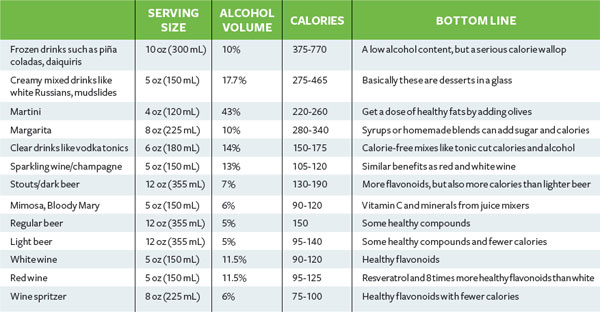
See Nuts and Seeds
Typical serving size: 1 medium (182 g), 95 calories
HOW THEY HARM
Pesticide residues
Bacterial infection
Allergies
WHAT THEY HEAL
Alzheimer’s disease
Colon cancer
High blood pressure
Weight gain
Blood sugar swings
Cardiovascular disease
High cholesterol
Teeth and gums
NUTRIENTS
Fiber
Flavonoids (antioxidants)
Procyanidins (cancer-fighting antioxidant)
Quercetin (antioxidant)
Vitamin C
QUICK TIP: Bake your way healthy
Golden Delicious, MacIntosh, and Granny Smith are some of the favored varieties for baking. Save Red Delicious and Gala for snacking.
BUYING
Choose apples that are:
| • | smaller |
| • | firm with no soft spots |
Avoid apples that are:
| • | larger |
| • | discolored |
| • | have soft spots, bruises, or worm holes |
STORING
Where: Refrigerator.
How: In plastic bags. Remove any that begin to decay immediately.
For how long: 6 weeks.
COOKING
| • | Layer apple slices with cashew butter on a toasted whole wheat English muffin. |
| • | Serve apple wedges on a vegetable crudités platter. |
| • | Roast apple chunks with chicken wings. |
RECIPES TO TRY
| • | Pasta with Cabbage, Apples, and Leeks |
| • | Herbed Chicken and Apple Burgers |
| • | Fruity Brussels Sprouts |

Typical serving size: 3 medium (115 g), 51 calories; ¼ cup dried (33 g), 78 calories
HOW THEY HARM
Allergies
Cavities
WHAT THEY HEAL
Cancer
High cholesterol
High blood pressure
Nerves and muscles
Eyes
NUTRIENTS
Beta-carotene
Iron
Pectin (soluble fiber)
Potassium
Vitamin C
BUYING
Choose apricots that are:
| • | plump |
| • | golden orange |
| • | slightly soft |
Avoid apricots that are:
| • | pale yellow or greenish-yellow |
| • | very firm |
| • | shriveled |
| • | bruised |
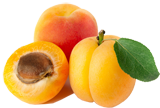
QUICK TIP: Skip the pit
Doctors warn that apricot pits in any form should not be ingested because eating them could cause cyanide poisoning.
Best time to buy: summer
When buying dried apricots, avoid ones that are brown, which means they’ve been treated with sulfites.
STORING
Where: Refrigerator when ripe. To help them ripen, place apricots in a paper bag with an apple.
How: Unwashed, in a paper or plastic bag.
For how long: 2 days.
COOKING
| • | Broil halves sprinkled with brown sugar and cinnamon; top with Greek yogurt. |
| • | Toss chopped dried apricots into a wild rice pilaf. |
| • | Mix all-fruit apricot spread with grated ginger as a glaze for grilled shrimp. |
RECIPES TO TRY
| • | Turkey Bacon and Apricot Bites |
| • | Wheat Berry Salad with Dried Apricots |
| • | Fruit Salad with Spiced Coconut |
Typical serving size: 1 medium, cooked (120 g), 64 calories
HOW THEY HARM
Allergies
WHAT THEY HEAL
Skin cancer
Indigestion
NUTRIENTS
Fiber
Folate
Silymarin (anticancer compound)
BUYING
Choose artichokes that:
| • | are firm without “give” |
| • | are compact and heavy for their size |
| • | have thick, green, fresh-looking scales |
| • | squeak when squeezed |
Avoid artichokes that have:
| • | thin stalks |
| • | large areas of brown on the scales |
| • | spreading scales |
| • | grayish-black discoloration |
| • | mold |
| • | worm injury |
Best time to buy: spring
STORING
Where: Refrigerator.
How: Unwashed, in a plastic bag.
For how long: 1 week. For maximum taste and tenderness, cook as soon as possible.
COOKING
| • | Toss thinly sliced raw baby artichokes into a mixed green salad. |
| • | Top bruschetta with sliced marinated artichoke hearts and grated parmesan. |
| • | Stir frozen artichoke hearts into a chicken stew about 10 minutes before the end of cooking time. |
RECIPES TO TRY
| • | Orange Chicken with Artichokes and Sun-Dried Tomatoes |
| • | Artichokes with Lentils and Lima Beans |
| • | Warm Artichoke and Bean Dip |
Typical serving size: ½ cup cooked (90 g), 20 calories
HOW IT HARMS
Gout
WHAT IT HEALS
Cancer
Aging
Cognitive decline
Edema
Stress
NUTRIENTS
Asparagine (natural diuretic)
Chromium
Folate
Vitamin C
Vitamin K
BUYING
Choose asparagus that are:
| • | firm, yet tender |
| • | smooth and round |
| • | deep green on the stalks |
| • | purplish on closed, compact tips |
| • | narrow in diameter (thicker ones are less tender) |
Avoid asparagus with:
| • | open and spread-out tips |
| • | mold or decay |
| • | ridges up and down the spear |
| • | excessive sand |

QUICK TIP: Limit fridge time
Asparagus is best eaten the day it is purchased, because the flavor lessens with each passing day.
Best time to buy: early spring
STORING
Where: Crisper drawer of refrigerator.
How: Store stalks with bottoms wrapped in a damp paper towel. If you don’t have a crisper, put them in plastic bags and place them in the coldest part of the refrigerator.
For how long: 3 to 4 days.
COOKING
| • | Grill lightly oiled spears until browned. |
| • | Stir-fry pieces until crisp-tender, drizzle with Thai peanut sauce. |
| • | Bake spears coated with olive oil and grated parmesan cheese. |
RECIPES TO TRY
Typical serving size: ½ cup cubed (75 g), 120 calories
HOW THEY HARM
Weight gain
Allergies
WHAT THEY HEAL
High cholesterol
Cardiovascular disease
Cancer
Blood sugar swings
Insulin resistance
Hair
NUTRIENTS
Fiber
Folate
Magnesium
Monounsaturated fat
Potassium
Sterols (cholesterol-lowering compounds)
Vitamin B6
Vitamin E

BUYING
Choose avocados that are:
| • | slightly firm, but yield to gentle pressure if you’re planning to use immediately |
| • | firm if you’re planning on using them later |
Avoid avocados with:
| • | bruises |
| • | hard or soft spots |
STORING
Where: At room temperature to ripen; in the refrigerator when ripe.
How: In a paper bag to ripen, uncut.
For how long: 2 to 5 days to ripen; 2 to 3 days in fridge.
To retain a fresh green color, avocados should either be eaten immediately or should be sprinkled with lemon or lime juice or white vinegar.
COOKING
| • | Avocados are best eaten raw. |
| • | Serve sliced avocado with huevos rancheros. |
| • | Layer slices with sliced red onion, tomato, and lettuce on whole grain toast. |
| • | Stuff avocado half with chicken salad dressed with salsa. |
RECIPES TO TRY
| • | Individual Breakfast Tortilla |
| • | Shrimp Seviche with Avocado and Pumpkin Seeds |
| • | Papaya and Avocado Salad |
FOODS
B
Typical serving size: ½ cup sliced (75 g), 67 calories; 1 medium (7 to 8 in or 17 to 20 cm long) (118 g), 105 calories
HOW THEY HARM
Allergies
WHAT THEY HEAL
Stress, anxiety, and depression
High blood pressure
Blood sugar swings
Muscles
Teething pain
Sleeplessness
NUTRIENTS
Fiber
Potassium
Tryptophan
Vitamin B6
Vitamin C
BUYING
Choose bananas that are:
| • | firm |
| • | free of bruises |
| • | solid yellow and speckled with brown if you’re planning to use immediately |
| • | unripe (with green tips or practically no yellow color) if you’re planning to use later |
Avoid bananas that:
| • | have brown spots |
| • | are very soft |
| • | have a strong odor |
STORING
Where: Refrigerator when ripe. To ripen, leave at room temperature for a couple of days.
How: In the peel. The peel may turn brown in the refrigerator, but the fruit will not change.
For how long: 3 to 5 days.
COOKING
| • | Top sliced bananas with low-fat yogurt and a sprinkle of low-fat granola. |
| • | Add slices to chicken curry. |
| • | Drizzle lengthwise halves with honey, cinnamon, and chopped walnuts. |
| • | Serve chunks atop mango sorbet. |
RECIPES TO TRY:
| • | Grilled Fruit en Brochette |
| • | Cauliflower Salad with Cashews |
| • | Banana-Peanut Bread |
| • | Chocolate Banana Soufflés |
See also Grains
Typical serving size: ½ cup cooked (79 g), 97 calories
HOW IT HARMS
Allergies
WHAT IT HEALS
Cardiovascular disease
Weight gain
Blood sugar swings
Anemia
Muscles and nerves
NUTRIENTS
Fiber
Niacin
Selenium
Thiamine
BUYING
Choose:
| • | pearl, scotch, or pot barley for use in soups and casseroles |
| • | scotch or pot barley for more dietary fiber |
| • | barley meal when making breads |
| • | whole barley for the nutrition (you can often find whole, hull-less barley in the natural foods section) |
STORING
Where: Refrigerator or freezer.
How: In an airtight container.
For how long: 6 months.
COOKING
| • | Toss cooled cooked barley with chopped canned beets, red onion, and a dollop of plain yogurt. |
| • | Serve warm cooked barley with honey and milk for breakfast. |
| • | Toss ¼ cup cooked barley into banana bread batter for extra nutrients and fiber. |
RECIPES TO TRY
| • | Barley and Beet Salad |
| • | Broccoli and Pearl Barley Salad |
See also Lentils; Peanuts and Peanut Butter; Peas and Pea Pods; Soy
Typical serving size: ½ cup (86 to 128 g), 108 to 143 calories
HOW THEY HARM
Nutrient absorption
Gout
Favism (in susceptible people)
Allergies
Drug interaction
Flatulence
WHAT THEY HEAL
Cardiovascular disease
High cholesterol
Cancer
Diabetes
Weight gain

NUTRIENTS
Calcium
Copper
Fiber
Folate
Iron
Isoflavones (phytochemical that protects against heart disease)
Magnesium
Manganese
Phosphorous
Phytosterols (anticancer and cholesterol-lowering compounds)
Potassium
Protein
Saponins (cholesterol-lowering compounds)
Thiamin
Zinc
WARNING!
FOOD-DRUG INTERACTION
If you take a monoamine oxidase (MAO) inhibitor to treat depression, you should avoid fava beans; the combination can raise blood pressure.
BUYING
Choose beans that:
| • | are firm, clean, and whole (dried) |
| • | have a bright color and slight sheen (dried) |
Avoid beans that are:
| • | cracked or chipped (dried) |
| • | in cans with dents |
| • | past the sell-by date |
STORING
Where: Cool, dry place away from direct sunlight.
How: In an airtight container.
For how long: Up to 1 year.
Bean Counting
When planning meals with beans, here’s how to judge the amount of beans you’ll need:
15 oz (425 mL) canned beans = 1½ cups cooked beans, drained
1 lb dry beans = 6 cups cooked beans, drained
1 lb dry beans = 2 cups dry beans
1 cup dry beans = 3 cups cooked beans, drained
You can store cooked beans in an airtight container in the refrigerator for up to 3 days or in the freezer for several months.
COOKING
| • | Soak dried beans in water for at least 12 hours before cooking. |
| • | Rinse canned beans before using. |
| • | Simmer brown lentils in vegetable broth with carrots, celery, and onions for a quick soup. |
| • | Toss drained and rinsed cannellini beans with canned tuna, scallions, olive oil, and lemon juice. |
RECIPES TO TRY
| • | Italian White Bean Spread |
| • | Lentil Soup with Canadian Bacon |
| • | Couscous-Stuffed Peppers |
Typical serving size: 1 cup (104 g), 31 calories
HOW THEY HARM
Bacterial infection
Lupus
WHAT THEY HEAL
Cancer
NUTRIENTS
Calcium
Fiber
Iron
Protein
Sulforaphane (anticancer compound)
Vitamin C
BUYING
Choose sprouts that:
| • | are crisp with the buds attached |
| • | have firm, white roots that are slightly moist |
Avoid sprouts that are:
| • | musty smelling |
| • | slimy |
| • | dark |
STORING
Where: Crisper drawer of refrigerator.
How: Wash the sprouts thoroughly with water to remove any dirt, then place them in a plastic bag.
For how long: 3 days. Rinsing daily under cold water may extend their life. Sprouts can be frozen for up to 1 year if you’re going to cook them in the future.
COOKING
| • | Add bean sprouts to coleslaw. |
| • | Sprinkle sprouts on chili. |
| • | Blend a handful of sprouts in a smoothie. |
RECIPES TO TRY
| • | Crab and Avocado Salad |
| • | Sesame Greens and Bean Sprouts |

QUICK TIP: Avoid sprouts if indicated
Children, the elderly, and people with weak immune systems should avoid eating sprouts because they have been associated with outbreaks of salmonella and E.coli infection. Alfalfa sprouts can also prompt a flare-up of symptoms in people with lupus. You can reduce risk of illness by cooking sprouts before eating them.
Typical serving size: 3 oz (90 g), calories vary depending on the cut (see charts What’s in the Beef? and What’s the Best Cut of Veal?)
HOW THEY HARM
Cardiovascular disease
Cancer
Bacterial infection
Hormones
WHAT THEY HEAL
Anemia
Weight gain
Bones, muscles, cartilage, skin, and blood
NUTRIENTS
Iron
Phosphorous
Potassium
Protein
Selenium
Vitamin B6
Vitamin B12
Vitamin D
Zinc
BUYING
| • | When buying raw meat, select it just before checking out at the register. |
| • | If available, put the packages of raw meat in disposable plastic bags, to contain any leaks. |
Choose:
| • | lean cuts (see charts What’s in the Beef? and What’s the Best Cut of Veal?) |
| • | bright red beef (maroon if vacuum packed) |
| • | whitish veal with pink highlights |
| • | beef and veal that is firm to the touch |
Choose the leanest cuts for the dish you want to make. The following all contain 10 grams or less of total fat per 3-oz (90-g) serving, and are organized first by cooking method, then from least to most fatty.

QUICK TIP: Skim excess fat
A quick way to remove fat from pan drippings is to drop an ice cube into the cooled liquid. The fat will harden around the ice cube and can be easily removed.
Avoid:
| • | ground beef that contains pink slime (listed on labels as Lean Finely Textured Beef) |
| • | products with damaged packaging or excess moisture |
STORING
Where: Refrigerator or freezer.
How: In original packaging if possible. Otherwise, tightly wrap in plastic wrap or freezer paper. If freezing longer than 2 months, overwrap these packages with airtight heavy-duty foil, plastic wrap, or freezer paper or place the package inside a plastic bag.
For how long: 1 to 2 days for fresh hamburger, ground beef or veal, and stew meats (3 to 4 months frozen); 3 to 5 days for fresh steaks, chops, and roasts (4 to 6 months for frozen chops, 6 to 12 months for frozen steaks and roasts).
COOKING
| • | Start with 4 oz (125 g) of raw meat to end up with 3 oz (90 g) cooked. |
| • | Trim all visible fat from your meat. Reduce fat further by broiling, grilling, or roasting on a rack (so fat can drip away). |
| • | Cook ground beef until it reaches 160°F (71°C). Don’t eat ground beef patties that are still pink in the middle. |
| • | Chill soups and stews so that the congealed fat can be removed easily, and then reheat the dishes before serving. |
| • | Layer thinly sliced cold roast beef on mini rye toast spread with horseradish and plain yogurt for an appetizer. |
| • | Stir-fry thin strips of boneless beef top sirloin with red bell pepper, garlic, spinach, and a splash of balsamic vinegar. |
| • | Roast chunks of marinated veal round steak with cherry tomatoes and pearl onions. |
The following cuts all contain 10 grams or less of total fat per 3-oz (90-g) serving, and are organized first by cooking method, then from least to most fatty. Trim all visible fat before you cook.
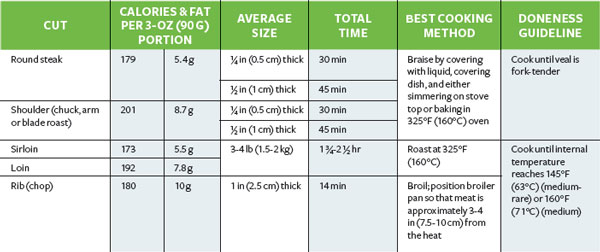
RECIPES TO TRY
| • | Caraway-Coated Pepper Steak with Cherry Sauce |
| • | Pot Roast with Root Vegetables |
| • | Beef-Fillet Salad with Mustard Vinaigrette |
| • | Tuscan Veal Chops |
| • | Beef in Lettuce Wraps |
Typical serving size: ½ cup boiled, sliced (68 g), 29 calories
HOW THEY HARM
Kidney stones and gout (beet greens can aggravate these conditions)
Discolored urine and stools
WHAT THEY HEAL
Cancer
Cardiovascular disease
Dementia
High blood pressure
Constipation
Eyes and nerves
NUTRIENTS
Beta-carotene
Calcium
Fiber
Folate
Iron
Potassium
Protein
Vitamin B6
Vitamin C
Vitamin K
BUYING
Choose beets that:
| • | are small, with greens still attached |
| • | have unblemished skin |
| • | have sturdy, unwilted greens |
Avoid beets that are:
| • | elongated with round, scaly areas around the top surface |
| • | wilted, flabby, rough, or shriveled |
Best time to buy: summer and autumn
Beets are also available canned and pre-cooked for easier preparation.
STORING
Where: Refrigerator.
How: Trim each beet, but leave about 1 inch (2.5 cm) of the stem. Place in a plastic bag.
For how long: 2 weeks.
The greens (which are rich in nutrients) wilt quickly, so use them within a day or two.
COOKING
| • | Boil beets unpeeled to retain nutrients and deep red color. |
| • | Add shredded raw beets to salads. |
| • | Stir finely chopped beet greens into vegetable soup shortly before the end of cooking. |
| • | Stir-fry matchstick-cut beet slices with sliced red cabbage. |
| • | Cook and serve beet greens, the most nutritious part of the vegetable, like spinach or Swiss chard. |
RECIPES TO TRY
| • | Raspberry-Beet Smoothie |
| • | Balsamic Beets with Toasted Pecans |
| • | Barley and Beet Salad |
| • | Orange Beets |
See also Cranberries
Typical serving size: ½ cup (62 to 76 g), 25 to 42 calories
HOW THEY HARM
Allergies
Kidney and bladder stones
Pesticide residue
Intestinal irritation
Dark stools
WHAT THEY HEAL
Cancer
Diabetes
Memory loss
High cholesterol
High blood pressure
Birth defects
Macular degeneration
Constipation
Skin
NUTRIENTS
Anthocyanins (antioxidant)
Ellagic acid (cancer-fighting substance)
Fiber
Folate
Pectin (soluble fiber)
Potassium
Vitamin C
BUYING
Choose berries that are:
| • | firm |
| • | plump |
| • | deep in color |
Avoid berries that are:
| • | soft or watery |
| • | mushy |
| • | moldy |
| • | dehydrated looking or wrinkled |
| • | in containers with juice stains |
Best time to buy: summer
STORING
Where: Crisper drawer of refrigerator.
How: In original container (remove any moldy or deformed berries first).
For how long: 1 day to 1 week depending on ripeness (raspberries spoil faster; blueberries tend to last the longest).
COOKING
| • | Wash berries just before eating or recipe preparation. |
| • | Top strawberry halves with a dollop of part-skim ricotta cheese whipped with grated orange peel. |
| • | Toss blueberries into a spinach salad. |
| • | Stir raspberries into oatmeal. |
RECIPES TO TRY
| • | Blueberry and Cranberry Granola |
| • | Lemony Blueberry Cheesecake Bars |
| • | Mixed Berry and Stone Fruit Soup |
| • | Peach and Blackberry Phyllo Pizzas |
| • | Broccoli Salad with Almonds and Dried Cranberries |
See Berries

See Berries
Typical serving size: 1 Tbsp (7 g), 14 calories
HOW IT HARMS
Irritable bowel syndrome (can aggravate symptoms in people with this condition)
Mineral absorption (in raw bran only)
WHAT IT HEALS
Cancer
Heart attack risk
Weight gain
Diverticulitis
Diabetes
Constipation
Hemorrhoids
NUTRIENTS
Fiber
BUYING
Choose bran that is:
| • | in a well-sealed container |
| • | from a store that has a high product turnover because bran can go rancid |
Avoid bran that:
| • | contains any clumps |
You can find wheat and oat bran in the cereal or baking section of grocery and natural food stores.

STORING
Where: Dark, dry, cool place.
How: In a tightly sealed container.
For how long: Up to 6 months in the refrigerator; up to 1 year in the freezer.
COOKING
| • | Replace ¼ cup (50 mL) flour with bran in quick bread or muffin recipes. |
| • | Coat fish fillets with bran before sautéeing. |
| • | Add bran to a fruit smoothie. |
RECIPES TO TRY
| • | Pear Rhubarb Muffins |
| • | Toasted Oat-Raisin Bread |
QUICK TIP: Add a little at a time
Gradually increase your intake of bran until your body gets used to it, and drink plenty of water. This will prevent gastrointestinal problems like bloating and gas.
See also Grains
Typical serving size: 1 slice (about 26 g), see chart What kind of Bread is Healthiest? for calories
HOW IT HARMS
Celiac disease (causes symptoms in people with this disease)
Allergies
Diabetes (white bread)
Fat storage (white bread)
High blood pressure (high-sodium bread)
WHAT IT HEALS
Diabetes (whole grain bread)
Weight gain (whole grain bread)
Anemia (fortified or enriched bread)
NUTRIENTS
Fiber (whole grain bread)
Folate
Iron
Niacin
Riboflavin
Thiamine
BUYING
Choose breads that:
| • | are made with whole grains |
| • | contain at least 3 g of fiber per serving |
| • | are 100% whole wheat |
Avoid breads that:
| • | list sugar in any form as one of the first four ingredients |

STORING
Where: At room temperature or in freezer, if you plan to keep it beyond its “best before” date or if you think it will become moldy. Don’t store bread in the fridge. A single day in the fridge is equivalent to 3 days at room temperature.
How: In its wrapper.
For how long: You’ll see the “best before” date on the plastic tie or wrapper. In the freezer, 3 months.
Eat crusty bread and rolls the day you buy them, because they become stale quickly.
COOKING
| • | Make French toast with (day-old) raisin bread. |
| • | Cut dried rye bread into croutons to garnish a red cabbage salad. |
| • | Serve minestrone over a slice of dry whole wheat bread. |
RECIPES TO TRY
| • | Tomato Biscuits |
| • | Multigrain Seeded Loaf |
| • | Carrot-Flecked Corn Bread |
| • | Cod with Gremolata Crust |
Choose the highest-fiber breads that are appropriate for your dishes. Here’s a guide to some of the most common types, listed in order from most to least grams of fiber per 2-oz (60-g) serving.
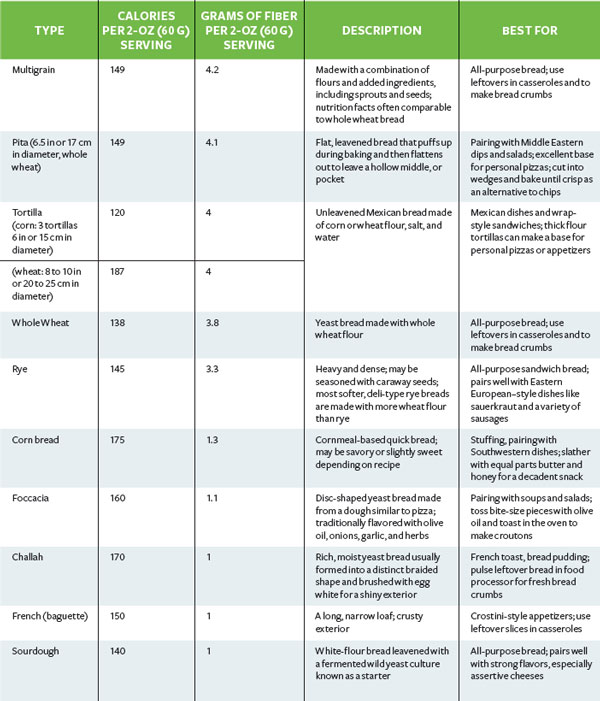
Typical serving size: ½ cup cooked, chopped (78 g), 27 calories; ½ cup raw, chopped (44 g), 15 calories
HOW IT HARMS
Bloating and flatulence
WHAT IT HEALS
Bladder cancer
Colorectal cancer
Breast cancer
Lung cancer
Cardiovascular disease
Bone health
Colds
Skin
Weight gain
NUTRIENTS
Antioxidants
Beta-carotene
Calcium
Fiber
Folate
Potassium
Sulforaphane (anticancer compound)
Vitamin C
BUYING
Choose broccoli bunches with:
| • | florets that are dark green, purplish, or bluish green |
| • | tightly closed buds |
| • | stalks that are very firm and slender |
Avoid bunches that have:
| • | pale or yellowing florets |
| • | bendable or rubbery stalks |
| • | open, flowering, discolored, or water-soaked bud clusters |
| • | tough, woody stems |
STORING
Where: Crisper drawer of refrigerator.
How: Unwashed in an open plastic bag.
For how long: A day or two after purchasing.
COOKING
| • | Steam, cook in the microwave, or stir-fry with a little broth or water to preserve vitamin and mineral content. |
| • | Cut an X in the bottom of each stalk for more even cooking. |
| • | Cooked broccoli should be tender enough so that it can be pierced with a sharp knife, and still remain crisp and bright green in color. |
| • | Stir-fry broccoli chunks with garlic and teriyaki sauce. |
| • | Roast florets coated with oil and curry powder on a baking sheet until browned. |
| • | Simmer chopped broccoli in chicken broth until tender; puree for soup. |
RECIPES TO TRY
| • | One-Egg Omelet with Chopped Broccoli, Tomatoes and Cheddar |
| • | Orange Beef with Broccoli and Jicama |
| • | Vegetable Pot Pie |
| • | Pasta Primavera |
| • | Orange-Walnut Broccoli |

Typical serving size: 1 cup cooked (155 g), 65 calories
HOW THEY HARM
Bloating and flatulence
WHAT THEY HEAL
Cancer
Cardiovascular disease
High blood pressure
Birth defects
Digestion
Cataracts
Weight gain
NUTRIENTS
Beta-carotene
Fiber
Folate
Phytochemicals
Potassium
Vitamin C
BUYING
Choose brussels sprouts that are:
| • | small, firm, compact sprouts |
| • | bright green in color |
| • | unblemished |
| • | displayed in stores chilled |
Avoid brussels sprouts that have:
| • | yellow or wilted leaves |
| • | a strong, cabbage-like odor |
| • | a puffy or soft feel |
Best time to buy: autumn
STORING
Where: Refrigerator.
How: Do not wash or trim sprouts before storing them in a plastic bag. Remove any yellow or wilted outer leaves. For sprouts packaged in a cellophane-covered container, take off the wrapping, examine them, remove any that are in bad condition, return them to container, and re-cover with cellophane.
For how long: 3 to 5 days.
COOKING
| • | Cut an X in the bottom of the stem for even cooking when using the sprouts whole. |
| • | Make a slaw with shaved brussels sprouts. |
| • | Roast brussels sprouts with pork loin and carrot chunks. |
| • | Sprinkle shredded cheddar cheese over cooked brussels sprouts. |
RECIPES TO TRY
| • | Braised Chicken with Winter Vegetables |
| • | Fruity Brussels Sprouts |
| • | Brussels Sprouts with Caraway Seeds |
See Grains
See Grains
IN MODERATION ONLY
Butter and margarine are both high in calories—one tablespoon has more than 100 calories—and they both contain fats that may be harmful to your heart. So it’s important to use both in moderation and choose the one that will be most satisfying to you.

KEEP IT HEALTHY
Make it soft. Buy soft trans fat free margarines in tubs. The softer your spread, the less you’ll use.
Combine it with other ingredients. You can reduce the amount of butter or margarine you need to use by boosting flavor with herbs, spices, or low-fat ingredients. Top baked potatoes with chives and blended low-fat cottage cheese. When making cakes, cut the amount of butter or margarine by one-third to one-half and add about half a cup of applesauce for moisture.
Halve it with olive oil. Beat a soft stick of butter until it is smooth. Then slowly beat in ¼ to ½ cup olive oil. You’ve just significantly cut the amount of saturated fat while adding loads of healthy monounsaturated fat.
Choose margarine with plant sterols. Research has shown that these types of margarines actually improve cholesterol levels.
See Squash
FOODS
C
Typical serving size: ½ cup cooked, shredded (75 g), 17 calories; 1 cup raw, chopped (89 g), 22 calories
HOW IT HARMS
Bloating and flatulence
High in calories (some coleslaw and sauerkraut)
Sulfites (sauerkraut and other prepared foods
WHAT IT HEALS
Colon cancer
Breast cancer
Cancers of the uterus and ovaries
Diabetes
Weight gain
NUTRIENTS
Beta-carotene
Fiber
Folate
Indoles (anticancer compound)
Potassium
Sulphoraphane (anticancer compound)
Vitamin C
Vitamin K
BUYING
Choose cabbage that has:
| • | a tight, heavy head |
| • | a vibrant green or red color, depending on type |
Avoid cabbage that has:
| • | wilted, discolored, or dried outer leaves |
| • | large blemishes |
| • | separation of the leaves from the core |
STORING
Where: Refrigerator.
How: Unwashed and covered loosely with a plastic bag.
For how long: Up to 2 weeks for fresh, uncut heads; 5 to 6 days for sliced cabbage.
To prevent discoloration, rub cut surfaces with lemon juice.
COOKING
| • | Cook cabbage quickly in an uncovered pan with as little water as possible to minimize odor. Overcooking can destroy the cabbage’s stores of vitamin C. |
| • | Stir-fry sliced green cabbage with scallions and grated ginger until golden. |
| • | Use shredded savoy cabbage as a base for shrimp salad. |
| • | Add slices of napa cabbage to beef noodle soup. |
RECIPES TO TRY
| • | Pork Chops and Cabbage |
| • | Pasta with Cabbage, Apples and Leeks |
| • | Thai-Style Beef Sandwich |
| • | Brown Rice with Cabbage and Chickpeas |
| • | Napa Cabbage Slaw with Peanut Dressing |
IN MODERATION ONLY

The combination of fat and sugar in these foods makes them nearly irresistible—no wonder they’re high on most people’s list of favorite foods. Research has shown that this combo actually turns on pleasure sensors in the brain, making you desire more. Unfortunately these tasty treats offer little to no nutritional value, and eating too many of them can lead to weight gain (some desserts can have as many as 1,500 calories), diabetes, and high cholesterol. Additionally, most packaged baked goods are loaded with trans fats, man-made fats that contribute to heart disease. About the only upside to these foods are the mood and energy boosts they provide, However, both are short lived. But don’t try to deprive yourself of these foods entirely, it will only make you crave them more. Instead, indulge wisely.
KEEP IT HEALTHY
Go for small portions. You’ll still enjoy the pleasures of these foods without all the fat and calories.
Make your own. Cut down on sugar and find healthy substitutes for unhealthy fat with the Healthy Baking tips.
IN MODERATION ONLY
While chocolate (especially dark chocolate) provides some health benefits (see Chocolate) and sugarless gum may help prevent cavities, the only thing other types of candy have to offer is sugar. While you may enjoy a quick energy burst, the jolt can have an equally negative effect. The rapid rise in blood sugar from eating candy causes insulin levels to spike. And when your blood sugar crashes after a high, you’re likely to feel hungry and tired. Sweets and sugary foods also form an acid bath that is corrosive to tooth enamel and create an environment where destructive, cavity-causing bacteria flourish. The one group that actually benefits from candy in small amounts is people who have hypoglycemia, when they experience severe drops in blood glucose. It’s unlikely that anyone can swear off candy forever, so enjoy it only occasionally.
KEEP IT HEALTHY
Pick your favorites. Don’t waste the calories on candy that’s just so-so. When you do indulge, make sure it’s a type you really love and then savor it.
Have sugarless gum. It’s calorie-free and may help stimulate saliva flow to flush food particles out of your mouth.
Chew, don’t suck. Candies that linger in the mouth longer are more damaging to teeth than those quickly swallowed. However, be careful of chewy caramels and other candies that leave sticky particles behind.
Go nuts. You can minimize blood sugar spikes by choosing candy with nuts in it.
See Melons
Typical serving size: ½ cup raw, chopped (64 g), 26 calories; ½ cup cooked, sliced (78 g), 27 calories
HOW THEY HARM
Skin yellowing
WHAT THEY HEAL
High cholesterol
Diabetes
Cancer
Macular degeneration
Cataracts
Night blindness
NUTRIENTS
Beta-carotene
Fiber
Potassium
BUYING
Choose carrots that have:
| • | bright green tops |
| • | firm bodies, small to medium size |
| • | smooth, even color without cracks |

QUICK TIP: Cook for more nutrition
Cooking increases carrots’ nutritional value because it breaks down the tough cellular walls that encase the beta-carotene.

Avoid carrots that have:
| • | large green areas at the top |
| • | soft spots |
| • | wilted leaves |
STORING
Where: Crisper drawer of refrigerator.
How: In perforated plastic bags without green tops; keep carrots away from apples and pears.
For how long: Up to 2 weeks.
COOKING
| • | Add a pat of butter or a tablespoon of olive oil to cooked carrots for better beta-carotene absorption. |
| • | Stir ½ cup shredded carrot into oatmeal raisin cookie dough. |
| • | Roast carrots tossed in soy sauce and honey until golden brown. |
| • | Add shredded carrots and minced chives to scrambled eggs. |
RECIPES TO TRY
| • | Carrot Cake with Cream Cheese Glaze |
| • | Flank Steak with Carrots and Red Pepper |
| • | Tuna and Carrot Sandwich on Rye |
| • | Braised Carrot, Celery, and Fennel |
Typical serving size: ½ cup cooked (62 g), 14 calories; ½ cup raw (50 g), 13 calories
HOW IT HARMS
Bloating and flatulence
WHAT IT HEALS
Cancer
Weight gain
NUTRIENTS
Bioflavonoids (anticancer compounds)
Fiber
Folate
Indoles (anticancer compounds)
Potassium
Vitamin B6
Vitamin C
BUYING
Choose cauliflower that has:
| • | a firm head |
| • | compact florets |
| • | a snowy, white color |
| • | crisp, green leaves |
Avoid cauliflower that has:
| • | brown spots |
| • | loose sections |
Best time to buy: autumn
STORING
Where: Crisper drawer of refrigerator.
How: In a plastic bag.
For how long: Up to 5 days.
COOKING
| • | Boil or steam cauliflower in a minimum amount of water to retain flavor and nutrients. |
| • | Stir-fry cauliflower florets with smoked paprika and garlic. |
| • | Simmer cauliflower in some chicken broth until tender; puree. |
| • | Sauté cauliflower florets and garlic in olive oil until golden; toss with whole-wheat pasta and slivered green olives. |
RECIPES TO TRY
| • | Spiced Cauliflower with Peas |
| • | Cauliflower and Spinach Casserole |
| • | Vegetable Pot Pie |
| • | Cauliflower Salad with Cashews |
| • | Broccoli and Cauliflower with Cream Sauce |
(also known as Celery Root)
Typical serving size: ½ cup cooked (78 g), 21 calories
WHAT IT HEALS
Weight gain
Cardiovascular disease
NUTRIENTS
Fiber
Phosphorous
Potassium
Vitamin B6
Vitamin C
Vitamin K
BUYING
Choose celeriacs that are:
| • | small- to medium-size |
| • | firm |
| • | heavy for their size |
| • | smooth |
Avoid celeriacs that:
| • | have soft spots |
Best time to buy: autumn and winter
STORING
Where: Refrigerator.
How: In an unsealed plastic bag.
For how long: Up to 1 week. If it turns soft, do not eat.
COOKING
| • | Place peeled celeriac in some water with a squeeze of lemon juice immediately after cutting, to prevent it from changing color. |
| • | Add shredded celeriac in place of celery in potato salad. |
| • | Cook shredded celeriac with a wild rice pilaf. |
| • | Layer sliced celeriac with potatoes in a gratin. |
RECIPES TO TRY
| • | Ham and Celeriac Pitas |
| • | Sweet Potato and Celery Root Puree |
| • | Pot Roast with Root Vegetables |

Typical serving size: ½ cup raw, diced (60 g), 9 calories
WHAT IT HEALS
Weight gain
High blood pressure
Inflammation
Cancer
NUTRIENTS
Beta-carotene
Fiber
Folate
Phthalides (compounds that may lower blood pressure)
Phytochemicals
Potassium
BUYING
Look for celery stalks that are:
| • | light green |
| • | crisp |
| • | firm |
| • | uniform in color |
| • | have dark leaves |
Avoid celery stalks that are:
| • | bruised |
| • | browning |
| • | hollow |
STORING
Where: Refrigerator.
How: Wrap the stalks loosely in plastic wrap.
For how long: 1 week.
QUICK TIP: Re-crisp your celery
To perk up celery that’s gone limp, place stalks in ice water in the refrigerator for a few hours.
COOKING
| • | Fill ribs with cashew butter and sprinkle dried cranberries on top. |
| • | Scatter thinly sliced celery over tacos. |
| • | Add minced celery to meat loaf. |
| • | Add the leaves to soups, salads, and other dishes enhanced by the flavor of celery. |
RECIPES TO TRY
| • | Spicy Vegetable Cocktail |
| • | Honey-Roasted Rack of Lamb |
| • | Three-Bean Salad with Manchego Cheese |
| • | Shellfish Salad with Herbed Lemon Dressing |
IN MODERATION ONLY
Not all cereals are created equally. While more than 90% of all commercial cereals are enriched or fortified with various vitamins and minerals—especially iron, niacin, thiamine, vitamin B6, and folic acid—many are high in sugar, and some are also high in salt. Even if you choose whole grain varieties, they can have too much sugar and salt. Granola types can also be high in fat from added oils. In addition, it’s very easy to pour out much larger portions than recommended, so you could end up consuming more calories than you think. But if you take the time to read labels and keep portion size in check, cereal can be a healthy way to start your day.
KEEP IT HEALTHY
Read carefully. Some cereals are low in calories and sugar when consumed in small servings. Pay extra attention to the serving size, which often varies from one box to the next.
Start with whole grain varieties or ones with bran added. Check the ingredient list. Whole grain or bran should be at the top.
Look for high-fiber cereals. Aim for at least 4 g per serving.
Keep salt and sugar in check. A serving should have no more than 240 mg of sodium and 13 g of sugar.
See also Milk and Dairy Products
Typical serving size: Varies; see chart Eggs
HOW IT HARMS
High in saturated fat and sodium
Migraines
Allergies
Bacterial infection
Drug interaction
WHAT IT HEALS
Diabetes
Metabolic syndrome
Bones
Muscles
Tooth decay
NUTRIENTS
Calcium
Phosphorous
Potassium
Protein
Vitamin B12
WARNING!
FOOD-DRUG INTERACTION
Tyramine—found in aged cheeses such as cheddar, blue cheese, and camembert—also interacts with monoamine oxidase (MAO) inhibitors, drugs sometimes used to treat depression, and can cause a life-threatening rise in blood pressure.
BUYING
Choose cheese that:
| • | contains the words “pasteurized milk” in the ingredient list |
| • | has uniformity in color and texture |
| • | is within the “use-by” date noted on the packaging |
Avoid cheese that:
| • | is missing or has an incomplete label, or does not contain a factory seal |
Take advantage of the broad range of low-fat cheeses on the market. Production methods have improved to allow for smoother texture and better taste.
STORING
Where: Crisper drawer of refrigerator.
How: Wrap hard cheese such as parmesan or gouda in waxed paper, then in plastic wrap; wrap blue cheeses and semihard cheeses in plastic wrap; and keep fresh cheeses (like mozzarella or feta) in their packaging in water and change the water every couple of days.
For how long: Hard cheeses up to several months; softer cheeses from 1 to 3 weeks after opening; large pieces of cheese tend to keep longer than shredded cheese.
COOKING
| • | Puree low-fat cottage cheese in a blender, then season to taste with salt-free herb blend. |
| • | Replace grated parmesan with half the amount of intensely flavored grated romano for pastas and salads. |
| • | Scatter crumbled reduced-fat feta cheese on veggie pita pizzas. |

Keep calories and fat in check while selecting the best type of cheese for the dishes you’re creating. The cheeses here are organized from least to most fatty.
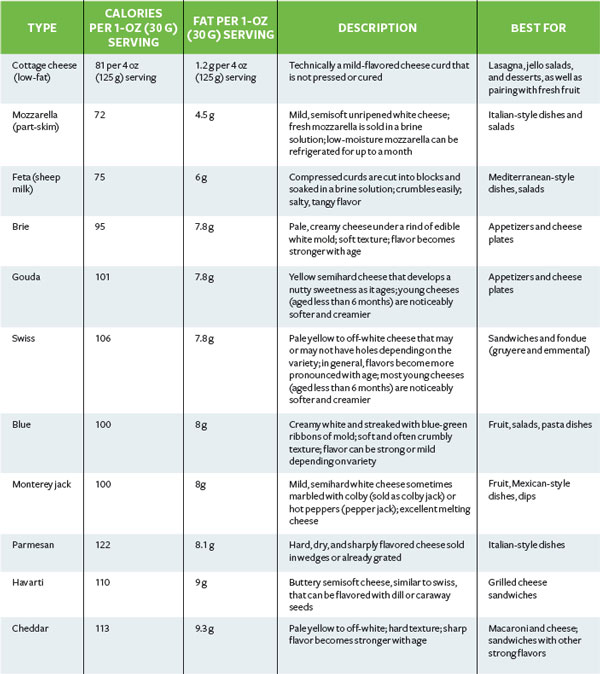
RECIPES TO TRY
| • | Huevos Rancheros |
| • | Pumpkin Maple Cheesecake |
| • | Turkey Braciole Stuffed with Provolone and Spinach |
| • | Baked Pasta with Garlic and Greens |
| • | Mediterranean Salad with Edamame |
Typical serving size: ½ cup fresh with pits (59 g), 37 calories; ¼ cup dried (40 g), 140 calories
HOW THEY HARM
Allergies
WHAT THEY HEAL
Inflammation
Cancer
High cholesterol
Gout
Arthritis
NUTRIENTS
Anthocyanins (antioxidant)
Beta-carotene
Pectin (soluble fiber)
Potassium
Quercetin (flavonoid)
Vitamin C
BUYING
Look for cherries that are:
| • | plump |
| • | firm |
| • | green stemmed |
Avoid cherries that are:
| • | bruised |
Best time to buy: early summer
STORING
Where: Refrigerator.
How: Unwashed, with stems attached in an open bag or container.
For how long: About 3 to 5 days; cherries spoil quickly, so eat them as soon as possible.
COOKING
| • | Stir quartered cherries into a wild rice pilaf just before serving. |
| • | Fold pitted cherries into a Waldorf salad. |
| • | Puree cherries and combine them with ice and cold seltzer for a refreshing drink. |
RECIPES TO TRY
| • | Caraway-Coated Pepper Steak with Cherry Sauce |
| • | Fruit Salad with Spiced Coconut |
| • | Savory Cranberry Chutney |
| • | Fruity Granola Mix |
See Nuts and Seeds
See Poultry
Typical serving size: ½ cup raw, chopped (75 g), 30 calories; 2 Tbsp dried (4 g), 30 calories
HOW THEY HARM
Hemorrhoids
Gastric discomfort
WHAT THEY HEAL
Cancer
Blood clots
Nasal congestion
Weight gain
NUTRIENTS
Beta-carotene
Bioflavonoids (anticancer compounds)
Capsaicin (may prevent blood clots)
Vitamin C
BUYING
Choose chile peppers that have:
| • | smooth skin |
| • | deep color |
Avoid chiles that are:
| • | bruised or wrinkled |
| • | mushy or have soft spots |

Red varieties generally have a higher nutritional content than the green ones.
STORING
Where: Fresh, in the refrigerator; dried, in a cool dry place away from sunlight.
How: Fresh, in a plastic bag; dried, in an airtight container.
For how long: Fresh, up to 2 weeks; dried, up to 4 months.
COOKING
| • | Remove the white ribs and seeds from chiles for a milder flavor. |
| • | Blend three or four tomatoes, cilantro, chopped onion, a couple of chiles, and a pinch of salt for instant fresh salsa. |
| • | Mix some minced jalapeño chiles into hamburger patties. |
| • | Add a pinch of dried red chiles to pasta salad. |
| • | Include some minced serrano chiles in a marinade for flank steak. |
RECIPES TO TRY
| • | Quinoa with Chiles and Cilantro |
| • | Green Pork Chili |
See Convenience and Processed Foods
Typical serving size: Varies; in general, 1 oz (28 g), 150 calories
HOW IT HARMS
High in sugar and fat
Migraines
WHAT IT HEALS
High blood pressure
Cardiovascular disease
Mood disorders
NUTRIENTS
Epicatechin (disease-fighting flavonoids)
Procyanidins (disease-fighting flavonoids)
BUYING
Choose chocolate that:
| • | is dark, with at least 60% cocoa for the most antioxidants |
| • | has a smooth shiny surface, if visible |
Avoid chocolate that has:
| • | a whitish or gray coating (which indicates blooming) |
| • | milk or white chocolate |
| • | a long ingredient list |
White chocolate is a mixture of cocoa butter, milk solids, and sugar. It has no cocoa solids and does not keep well. The darker the chocolate, the less fat and sugar it has.

STORING
Where: In a cool, dry place. Do not store in the refrigerator because this causes “blooming,” or separation of cocoa butter from the chocolate.
How: In a tightly sealed container or bag.
For how long: Up to 1 year.
COOKING
| • | Use crunchy, unsweetened cocoa nibs in place of chocolate chips in baked goods. |
| • | Substitute ½ cup unsweetened cocoa powder for the flour in pancake recipes. |
| • | Dip slices of crystallized ginger into melted bittersweet chocolate. |
RECIPES TO TRY
| • | Nutty Chocolate Chip Cookies |
| • | Chocolate-Almond Biscotti |
| • | Chocolate Banana Soufflés |
See Shellfish
Typical serving size: 1 cup raw, shredded (80 g), 283 calories
HOW THEY HARM
High cholesterol
WHAT THEY HEAL
Cravings
Digestion
Weight gain
NUTRIENTS
Fiber
Potassium
BUYING
Choose coconuts that have:
| • | a firm shell |
Avoid coconuts with:
| • | dark or soft spots |
STORING
Where: Refrigerator once it’s cut.
How: Wrapped tightly in plastic.
For how long: Up to 5 days; whole coconuts can be kept at room temperature for up to a month.
COOKING
| • | Use reduced-fat coconut milk in place of cow’s milk for french toast. |
| • | Toss shredded fresh coconut in a shrimp salad with lime dressing. |
| • | Sprinkle shredded coconut on high-fiber breakfast cereal. |
| • | Blend shredded raw coconut into smoothies. |
RECIPES TO TRY
| • | Thai Roasted Shrimp |
| • | Fruit Salad with Spiced Coconut |
| • | Thai Coconut Rice |
IN MODERATION ONLY
Drinking more than 400 to 500 mg a day of caffeine can pose a number of health problems. Some may just be annoying, like feeling jittery or making frequent trips to the bathroom. But others can be more serious. Caffeine prompts a temporary rise in blood pressure, increases calcium excretion, may interfere with conception, and may raise the risk of miscarriage. If you are susceptible to cardiac arrhythmias, have high blood pressure, suffer from migraines or headaches, are at risk for osteoporosis, are trying to conceive, or are pregnant, you should talk to your doctor about the effect that caffeine may have on you.
If you’re not at risk for any of these serious health problems, go ahead and enjoy your cup of joe. Research shows that a moderate intake can reduce your risk of diabetes, Alzheimer’s disease, colon cancer, Parkinson’s disease, and skin cancer.
KEEP IT HEALTHY
Limit caffeine to less than 500 mg a day. That’s the amount in about four 6-oz (180 mL) cups. Most coffee cups today are much bigger, so you may only get to have one or two cups a day. And don’t forget to include other sources of caffeine, such as tea or soft drinks, in your tally.
Watch out for specialty coffee drinks. While a 6-oz (180 mL) cup of sugar-free black coffee has only 4 calories, coffee drinks with syrups and whipped cream often have more fat and calories than a rich dessert.

See Kale and Other Cooking Greens
IN MODERATION ONLY
While condiments certainly add zest to food, they generally contribute little nutrition and sometimes add a lot of sugar, fat, sodium, cholesterol, or nitrites. Too much of those can lead to weight gain, high blood pressure, diabetes, heart disease, and even cancer. Used judiciously, though, condiments add variety and make food tastier.
KEEP IT HEALTHY
Stick to the good guys. Salsas, chutney, mustards, and hummus tend to be the lowest in fat and calories, although commercially prepared versions may still contain excess sugar or fat. Those made with cream, butter, egg yolk, and cheese tend to be the most unhealthy. Read labels carefully or make your own.
Buy modified versions. Many condiments are available in low-fat, nonfat, no-added-sugar, or other healthier options.
Check ingredients. If you have allergies or food intolerances, the culprits may be in these products, so read the labels carefully.
IN MODERATION ONLY
Convenience foods that require little or no preparation—from ready-to-eat breakfast cereals and canned, dried, or frozen fruits and vegetables, to prepackaged heat-and-serve meals—are practically a necessity in our busy lifestyles. Unfortunately, many are much less healthy than home-cooked versions because of extra sugar, salt, and fat, all of which can have adverse health effects. They also tend to be loaded with artificial flavorings, emulsifiers, fillers, preservatives, and trans fats that can increase your risk for heart disease. And processing often strips vitamins and minerals from foods. But nutritious picks that help busy cooks put meals together quickly do exist; you just have to be a savvy shopper.
KEEP IT HEALTHY
Go for fresh options. Precut veggies and fruit and rotisserie chicken are quick healthy options. Just don’t eat the skin on the chicken.
Boost nutrition. Add a fresh side salad to a meal consisting of processed food, like frozen lasagna, to provide a wide assortment of valuable nutrients.
Watch out for sauces. Vegetables and many fruits harvested and quick-frozen at their peak often have more vitamins than those picked before maturity, shipped long distances, and then placed on shelves. But you can undo those benefits if you choose varieties in high-calorie, high-fat sauces and syrups. Stick to plain varieties for the healthiest option.
Limit salt. Scan the nutrition panel carefully, and keep your daily intake under 2,300 mg of sodium.
Watch out for red-flag ingredients. Be wary of ingredient lists with the words “corn sweetener,” “corn syrup,” “corn syrup solids,” “high-fructose corn syrup,” “hydrogenated fats,” or “vegetable shortening.”
Choose whole grains. Look for packaged rice or noodle products made with brown rice or whole wheat pasta whenever possible. If you can’t find prepackaged foods with whole wheat pasta or brown rice, cook some up separately and then add it to the dish. Along with more fiber, it will increase the amount of food you have, so the sodium, sugar, and fat per serving will be less.

Typical serving size: 1 medium ear (90 g), 77 calories; ½ cup kernels (82 g), 67 calories
HOW IT HARMS
Pellagra (a niacin or tryptophan deficiency)
WHAT IT HEALS
Cardiovascular disease
Cancer
Macular degeneration
NUTRIENTS
Ferulic acid (anticancer compound)
Fiber
Folate
Lutein (antioxidant)
Potassium
Thiamine
BUYING
Choose corn that has:
| • | moist, green husks |
| • | shiny silks |
| • | plump and healthy kernels all the way to the tip |
| • | some heft for its size |
| • | been frozen rather than canned |
| • | no salt added, if you must buy canned |
To check the condition of the kernels, don’t strip the husk—it dries out the corn and leaves it susceptible to fungus. Instead, feel around the silk end for firm, plump kernels.
Avoid corn that:
| • | feels wrinkled, mushy, or dry |
Best time to buy: summer
STORING
Where: Crisper drawer of refrigerator.
How: With husks attached.
For how long: Within 1 to 2 days.
COOKING
| • | Use plain popcorn in place of bread for a poultry stuffing recipe. |
| • | Stir corn kernels into a vegetable casserole. |
| • | Toss corn kernels into a salad made with cooked red quinoa, minced onion, cilantro, and some salsa. |
RECIPES TO TRY
| • | Carrot-Flecked Corn Bread |
| • | Sweet and Spicy Snack Mix |
| • | Cod and Vegetable Stew |
| • | Bulgur with Dried Cherries and Corn |
See also Berries
Typical serving size: ½ cup whole (48 g), 22 calories; ¼ cup dried (30 g), 90 calories
HOW THEY HARM
Blood sugar spikes
Drug interaction
WHAT THEY HEAL
Urinary tract infections
Cardiovascular disease
Cancer
NUTRIENTS
Anthocyanins (antioxidants)
Fiber
Flavonols (plant chemical that prevents heart disease)
Proanthocyanidins (plant chemical that prevents heart disease)
Vitamin C
WARNING!
FOOD-DRUG INTERACTION
Do not drink cranberry juice if you are on the medication warfarin. The interaction between the juice and the drug may lead to bleeding.
BUYING
Choose cranberries that are:
| • | firm |
| • | brightly colored |
| • | unsweetened |
| • | bouncy when dropped |
| • | fresh or frozen |
Avoid cranberries that are:
| • | bruised or mushy |
| • | dry or shriveled |
| • | canned or sweetened |
Best time to buy: autumn
STORING
Where: Fresh, in the refrigerator; dried, in a cool dark place or in the refrigerator.
How: In their original plastic packaging or tightly wrapped.
For how long: Fresh, up to 4 weeks; frozen, up to a year; dried, 6 months on a shelf or up to a year in the refrigerator.

COOKING
| • | Add dried cranberries to walnut biscotti dough. |
| • | Stir some fresh cranberries into braised chicken about 10 minutes before cooking time is finished. |
| • | Add some fresh cranberries to an apple cobbler or pie filling. |
RECIPES TO TRY
| • | Rice-Stuffed Squash |
| • | Savory Cranberry Chutney |
| • | Cranberry-Peanut Cereal Bars |
| • | Broccoli Salad with Almonds and Dried Cranberries |
Typical serving size: ½ cup sliced (52 g), 7 calories
WHAT THEY HEAL
Weight gain
NUTRIENTS
Folate
Potassium
BUYING
Choose cucumbers that are:
| • | firm |
| • | brightly colored |
Avoid cucumbers that have:
| • | soft spots, blemishes, or bruises |
| • | wrinkled or dry looking skin |

QUICK TIP: Snack on cucumbers in hot weather
The interior flesh of cucumbers is about 20 degrees cooler than the outside temperature even if they aren’t chilled. And their high water content—about 95%—will keep you hydrated.
Best time to buy: summer
STORING
Where: Crisper drawer of refrigerator.
How: Unwashed and unpeeled; if peeled, wrap tightly in plastic wrap.
For how long: 1 to 2 days for unwaxed or peeled; up to 1 week for waxed.
COOKING
| • | If cucumber skin is waxed, peel before using. |
| • | Layer thinly sliced cucumbers on cheese, ham, or turkey sandwiches. |
| • | Puree peeled, seeded cucumber with plain yogurt, garlic, chopped dill, and a bit of ice water for a refreshing summer soup. |
| • | Dip cucumber sticks in baba ghanoush. |
RECIPES TO TRY
| • | Chunky Gazpacho with Garlicky Croutons |
| • | Greek Lamb Kebabs |
| • | Poached Salmon with Cucumber-Dill Sauce |
| • | Minty Melon Cups |
| • | Japanese Sushi Rolls |
FOODS
D
Typical serving size: 5 to 6 dates (40 g), 126 calories
HOW THEY HARM
Weight gain
Tooth decay
Drug interaction
WHAT THEY HEAL
Cancer
Bone loss
Cardiovascular disease
High blood pressure
NUTRIENTS
Calcium
Fiber
Iron
Magnesium
Manganese
Niacin
Polyphenols (anticancer compounds)
Potassium
Vitamin B6
WARNING!
FOOD-DRUG INTERACTION
Dates contain tyramine, an organic compound found in aged cheese, certain processed meats, red wine, and other products. Anyone taking monoamine oxidase (MAO) inhibitors to treat depression should avoid dates, because tyramine can interact with these drugs to produce a life-threatening rise in blood pressure. In some people, tyramine can also trigger migraine headaches.
BUYING
Choose dates that are:
| • | shiny |
| • | uniformly colored |

QUICK TIP: Refresh your dates
If they’ve been stored for an extended period of time, immerse them in hot water (about 80°F or 30°C) for about 20 to 30 minutes, allowing water to absorb to improve texture and taste. Remove, pat dry with a paper towel.
Avoid dates that are:
| • | cracked |
| • | discolored or have yellow or brown blemishes |
Fresh dates are classified according to their moisture content, falling into three categories: soft, semisoft, and dry. Most varieties in North America are semisoft, which are marketed fresh, as well as dried after part of their moisture has been evaporated.
Best time to buy: autumn
STORING
Where: At room temperature.
How: In an airtight container.
For how long: Several months. Refrigerated dates last up to 1 year.
COOKING
| • | Blend a couple of dates into a smoothie in place of other sweeteners and for added fiber. |
| • | Stuff dates with whole blanched almonds and drizzle with melted white chocolate. |
| • | Stir some chopped dates into tabbouleh salad. |
| • | Create a sweet and sour sauce for sautéed chicken breasts by deglazing the skillet with sherry vinegar and chopped dates. |
RECIPES TO TRY
| • | Hot Cereal with Apples and Dates |
| • | Fruity Brussels Sprouts |
| • | Chewy Date-Walnut Bars |
See Poultry
FOODS
E
See Soy
Typical serving size: ½ cup cooked (50 g), 18 calories (with no fat added)
HOW THEY HARM
Fat and calorie magnet
WHAT THEY HEAL
Weight gain
NUTRIENTS
Fiber
Anthocyanins (antioxidants)
BUYING
Choose eggplants that are:
| • | firm with thin skin |
| • | smaller |
| • | heavy for their size |
| • | deep purple to light violet or white |
Avoid eggplants that are:
| • | cracked or discolored |
| • | bruised or shriveled |
| • | yellowish or have blue or brown streaks |
STORING
Where: Crisper drawer of refrigerator.
How: Whole, no container or bag needed.
For how long: 5 to 7 days.
COOKING
| • | Eggplants’ spongy texture causes them to soak up more fat and calories than potatoes. For healthier cooking, use a preparation that requires minimal fat, such as broiling, baking, roasting, or stewing. If sautéing, use a nonstick pan and little oil. |
| • | Grill baby eggplant slices, then spread with ricotta cheese, pesto, and finely chopped tomato. Roll into tubes. |
| • | Grill eggplant wedges, then toss in a bowl with hoisin sauce and chile paste just to coat. |
| • | Stir-fry eggplant cubes in olive oil with chopped onion, zucchini, and tomato. |
| • | Slice eggplant into thin slivers and use in place of noodles in lasagna. |
| • | Cut eggplant in half and roast until soft. Scoop out the insides and mix with a bit of olive oil, salt, pepper, a crushed garlic clove, and a squeeze of lemon for a quick baba ghanoush. |
| • | Use it in place of meat in stews, casseroles, and sandwiches. |
RECIPES TO TRY
| • | Penne with Fresh Tomato Sauce and Grilled Eggplant |
| • | Rustic Grilled Vegetable and Rigatoni Salad |
| • | Grilled Eggplant Sandwiches with Red Pepper–Walnut Sauce |

QUICK TIP: Sprinkle with salt
To eliminate bitterness in some eggplants, sprinkle cubed or sliced eggplant with salt. Let it stand for half an hour, then drain it and blot it dry. The salt draws out excess moisture and reduces bitterness.
Typical serving size: 1 large (50 g), 75 Calories
HOW THEY HARM
Allergies
Bacterial infection
WHAT THEY HEAL
Cardiovascular disease
Cancer
Cataracts and macular degeneration
Memory
NUTRIENTS
Beta-carotene
Choline
Iron
Lutein
Protein
Vitamin B12
Vitamin D
Vitamin E
Zeaxanthin (antioxidant)
Zinc
BUYING
Choose eggs that are:
| • | enhanced with omega-3s (they’re lower in saturated fat and higher in vitamin E than regular eggs) |
| • | brown or white—they’re equally nutritious (free-range eggs may have slightly higher levels of carotenoids) |
Avoid eggs that are:
| • | cracked or stuck to the bottom |
| • | past the “use-by” date |
STORING
Where: In the main part of the refrigerator, not on the inside of the door.
QUICK TIP: Limit eggs if indicated
Doctors recommend that people with high cholesterol eat no more than three yolks a week. People with diabetes should limit consumption, too.
How: In its carton with the pointed end of the egg down.
For how long: Up to 3 weeks. (Eggs age more in 1 day at room temperature than in 1 week in the refrigerator.)
COOKING
| • | To be certain that eggs have been cooked long enough, boil them for at least 4 minutes, poach them for 5 minutes, or fry them for 3 minutes. Both the yolk and the white should be firm. Omelets and scrambled eggs should be cooked until firm and not runny. |
| • | Refrigerate hard-cooked eggs for up to a week for quick, easy snacks or sandwich fillings. |
| • | Stir-fry leftover cooked noodles or rice with leftover veggies and a beaten egg for a quick meal. |
| • | Top steamed asparagus with a poached egg and a sprinkling of parmesan cheese. |
RECIPES TO TRY
| • | Asparagus, Egg, and Ham Sandwiches |
| • | Mushroom and Bell Pepper Frittata |
| • | Zucchini-Carrot Crustless Quiche Squares |
| • | Fried Rice with Tofu and Vegetables |
FOODS
F
Typical serving size: 1 cup sliced (87 g), 25 calories
HOW IT HARMS
Skin irritation
WHAT IT HEALS
Weight gain
High blood pressure
High cholesterol
High blood sugar
Cancer
NUTRIENTS
Beta-carotene
Calcium
Fiber
Folate
Iron
Potassium
Vitamin C
BUYING
Choose fennel that has:
| • | firm bulbs |
| • | bright green stalks and leaves |
Avoid fennel that is:
| • | blemished |
| • | soft or has mushy spots |
Best time to buy: autumn to early spring
STORING
Where: Crisper drawer of refrigerator.
How: Unwashed in a sealed plastic bag.
For how long: Up to 5 days.
COOKING
| • | All parts of the plant are edible. It can be prepared raw in salads, or braised or sautéed as a side dish. |
| • | Marinate shrimp in cracked fennel seeds, lemon juice, and olive oil before grilling. |
| • | Dip fennel wedges into hummus. |
| • | Sauté fennel and sweet onion wedges until browned, then season with balsamic vinegar. |
| • | Use in place of celery in stews and soups. |
RECIPES TO TRY
| • | Braised Carrot, Celery, and Fennel |
| • | Grilled Oysters with Fennel and Spinach |
| • | Warm Kasha and Seafood Salad |
| • | Sicilian Pasta Salad |
Typical serving size: 2 small (80 g), 60 calories; ¼ cup dried (50 g), 124 calories
HOW THEY HARM
Diarrhea
Tooth decay
Canker sores
WHAT THEY HEAL
Cardiovascular disease
High cholesterol
Diabetes
Cancer
Bone loss
Constipation
NUTRIENTS
Calcium
Fiber
Iron
Manganese
Pectin (soluble fiber)
Potassium
Vitamin B6
BUYING
Choose figs that are:
| • | ripe and unblemished |
| • | a deep purple |
| • | soft, but not mushy |
Avoid figs that are:
| • | moldy or smell fermented |
| • | mushy or blemished |
Best time to buy: late summer to early autumn
STORING
Where: Refrigerator.
How: In a paper towel–lined container.
For how long: Within 2 days.
COOKING
| • | Macerate quartered dried figs in orange juice. |
| • | Use chopped dried figs in place of raisins. |
| • | Bake halved fresh figs with fresh pineapple wedges sprinkled with cinnamon. |
RECIPES TO TRY
| • | Sesame Fig Bars |
| • | Nutty Muesli |
| • | Fresh Figs with Raspberries and Rose Cream |
| • | Grilled Fruit en Brochette |
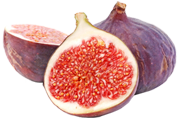
QUICK TIP: Pick the sweetest
Fig connoisseurs say to look for a drip of moisture at the hole on the bottom of the fruit.
See also Shellfish
Typical serving size: About the size of a deck of cards, or 3 oz (85 g); calories vary depending on variety (see chart Which type of Fish or Shellfish to Choose?)
HOW IT HARMS
Pollutants
Parasites
Bacteria and viruses
WHAT IT HEALS
Cardiovascular disease
Stroke
Inflammation
Memory loss
Macular degeneration
NUTRIENTS
Calcium (canned salmon and sardines with bones)
Magnesium
Niacin
Omega-3 fatty acids
Protein
Vitamin A (oily fish such as salmon)
Vitamin D (oily fish such as salmon)
Vitamin B12
Zinc
WARNING!
FOOD-DRUG INTERACTION
Because the lignans in flax are phytoestrogens, it may affect drugs such as Tamoxifen that are used to treat hormone-sensitive conditions. While some research suggests that it helps these conditions, more studies are needed. Talk to your doctor before eating flax while on Tamoxifen, or if you have hormone-sensitive ailments such as breast or uterine cancer, endometriosis, or fibroids.
BUYING
Shop at a busy fish counter—it means faster turnover and fresher fish. Or look for markets that keep fish covered (both top and bottom) with ice. The best sources of omega-3 fats are oily cold-water fish such as salmon, mackerel, trout, sardines, herring, and anchovies. You’ll also find them in halibut, bluefish, ocean perch, bass, red snapper, and smelts. Limit your intake of large bottom-feeders such as tuna, shark, king mackerel, tilefish, and swordfish because they tend to be high in mercury.
In general, cook fish for 10 minutes for every inch of thickness, or until it flakes easily with a fork. Before cooking clams, oysters, and mussels, discard any that don’t close with a light tap on the shell; cook until the shells open, and avoid eating any that do not open during cooking. When preparing lobster, scallops, shrimp and squid, cook just until firm; longer cooking times can result in a tough, chewy texture. Octopus traditionally requires a longer cooking time, usually at least an hour, to become tender. Because most of the fat in fish is healthy (as noted on the chart below), don’t shy away from fatty types.
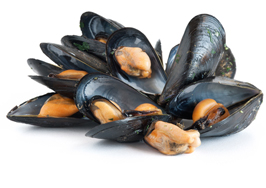
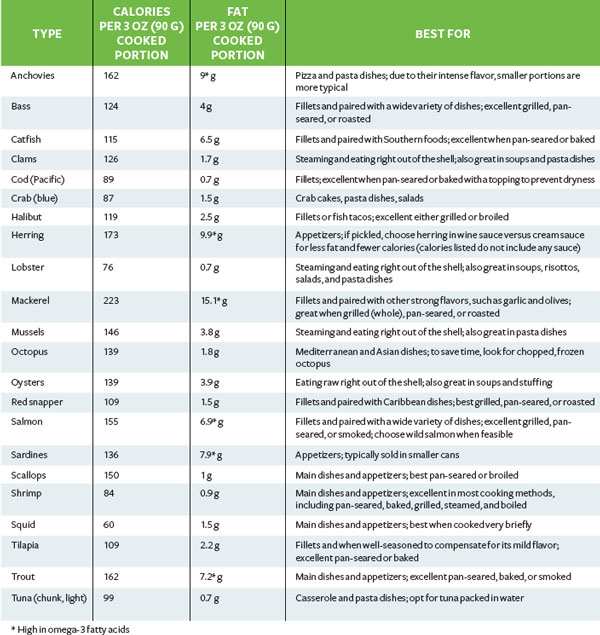
Choose fish that has:
| • | bright, bulging, and clear eyes (whole fish) |
| • | bright red gills (whole fish) |
| • | bright, glossy skin with tight scales (whole fish) |
| • | moist, resilient skin (fillets) |
| • | firm flesh |
| • | a fresh, briny odor |
Avoid fish that has:
| • | gray or cloudy eyes (whole fish) |
| • | grayish or pink gills (whole fish) |
| • | any discoloration (fillets) |
| • | gaps in the flesh (fillets) |
| • | a fishy odor |
When buying canned fish, choose those packed in water rather than oil. For tuna, go with the light or albacore variety.
STORING
Where: In the coldest part of the refrigerator, or in the freezer.
How: Wrapped in plastic wrap.
For how long: Fresh, 1 to 2 days; frozen, within 3 months for fatty fish, and 6 months for lean fish.
COOKING
| • | Serve slivers of smoked whitefish with a spinach salad. |
| • | Brush grilled halibut with teriyaki sauce. |
| • | Crumble drained canned salmon into a pasta salad. |
RECIPES TO TRY
| • | Roasted Mackerel with Cherry Tomatoes and Potatoes |
| • | Monkfish and Mussel Kebabs |
| • | Snapper and Snaps in a Packet |
| • | Grilled Salmon Salad |
| • | Tossed Tuna Salad Niçoise |
See also Nuts and Seeds
Typical serving size: 1 to 2 Tbsp, ground (7 to 14 g), 33 to 66 calories
HOW IT HARMS
Fetus and nursing infants (check with doctor if pregnant or nursing)
Bleeding problems (avoid if you have a bleeding disorder)
Drug interaction
WHAT IT HEALS
Cardiovascular disease
High cholesterol
Menopause symptoms
Cancer
Constipation
NUTRIENTS
Alpha linolenic acid (ALA—a heart healthy omega-3 fatty acid)
Fiber
Lignans (phytoestrogens)
BUYING
In the grocery, you can find flaxseeds and flaxmeal in the same aisle as flour. Flaxseed oil is often found in the pharmacy section.
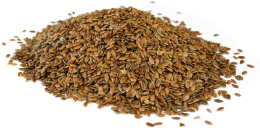
Choose flaxseeds that are:
| • | whole (grind them in a blender or coffee grinder as needed) |
| • | from a store with a high turnover, if ground |
| • | refrigerated, if ground |
| • | vacuum-packed, if ground |
Avoid flaxseeds that:
| • | are not in an opaque container |
| • | don’t come with a “use-by” date |
STORING
Where: In the refrigerator or freezer, especially if ground.
How: In an airtight, opaque container in the fridge if whole or in oil form; in the freezer if ground.
For how long: Up to 1 year if whole; if ground, a few weeks in the freezer or until the best-before date on the package.
If flaxseed tastes bitter or smells sharp or fishy, throw it away.
COOKING
| • | Replace 2 Tbsp of flour in cookie recipes with an equal amount of flaxmeal. |
| • | Use flaxmeal to bread fish or chicken cutlets to be baked or sautéed. |
| • | Spread corn on the cob with a blend of flaxseed oil and Cajun seasoning. |
| • | Add ground flax to muffin or pancake batter. |
| • | Sprinkle ground flax onto oatmeal. |
RECIPES TO TRY
| • | Broccoli Salad with Almonds and Dried Cranberries |
| • | Berry-Flaxseed Smoothie |
| • | Chicken-Kale Soup with Roasted Pepper Puree |
| • | Cranberry-Peanut Cereal Bar |
| • | Whole Wheat Flaxseed Bread |
See Grains
FOODS
G
See also Herbs and Spices
Typical serving size: 3 cloves (9 g), 12 calories
HOW IT HARMS
Bleeding problems
Stomach irritation
Drug interaction
WHAT IT HEALS
High blood pressure
Atherosclerosis
Cardiovascular disease
Diabetes
Colon and rectal cancer
Infections
Tick bites
NUTRIENTS
Allicin
Antibacterial, antifungal, and antiviral compounds
WARNING!
FOOD-DRUG INTERACTION
Garlic may interfere with the effectiveness of saquinavir, a drug used to treat HIV infection.
BUYING
Choose garlic that:
| • | is dry |
| • | has lots of papery sheath covering it |
| • | looks and feels plump and firm |
| • | is white or off-white |
Avoid garlic that is:
| • | shriveled |
| • | moldy |
| • | mushy |
| • | sprouting |
Best time to buy: late summer
STORING
Where: In a cool, dark, and dry place with plenty of circulation or a clay garlic holder; not in the refrigerator.
How: In its papery covering.
For how long: Several weeks.
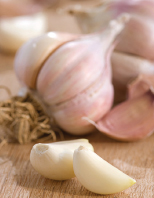
QUICK TIP: Prepare before cooking
To activate garlic’s full nutritional power, it should be chopped or crushed and then left to stand for 10 minutes before cooking. This allows allicin and its potent derivatives to be activated.
COOKING
| • | Boil peeled garlic cloves with potatoes to season the mash. |
| • | Stir-fry spinach with extra-virgin olive oil and plenty of minced garlic. |
| • | Wrap a whole head of garlic in foil and bake in the oven for 30 minutes for a soft spread for breads or potatoes. |
| • | Sauté garlic and add it to tomato sauce, or mince it and add it raw. |
RECIPES TO TRY
Typical serving size: 1 tsp or 1-in (2.5-cm) diameter slice, raw (2 g), 2 calories; 1 tsp ground (2 g), 6 calories
HOW IT HARMS
Bleeding problems
Miscarriage
Inflamed mouth and mucous membranes
Drug interaction
WHAT IT HEALS
Motion sickness and nausea
Pain
Cancer
Flatulence
NUTRIENTS
Beta ionone (cancer-fighting compound)
Gingerols (phenol compound)
Shogaols (phenol compound)
BUYING
Fresh ginger can be found at any supermarket, but dried and powdered forms are readily available, as are ginger juices and teas.
Choose ginger that:
| • | is plump and firm |
| • | has smooth skin |
| • | has a spicy fragrance |
Avoid ginger that is:
| • | withered |
| • | cracked |
| • | moldy |
| • | blemished |
QUICK TIP: Remedy your cold naturally
Here’s a comforting way to relieve congestion: Make ginger tea by simmering one or two slices of fresh ginger root in water for 10 minutes; add a pinch of cinnamon for extra flavor.
STORING
Where: In the refrigerator or freezer.
How: Unpeeled and dry, in a sealed plastic bag with all the air pressed out.
For how long: 2 weeks in the refrigerator; up to 2 months in the freezer.
COOKING
| • | Sauté minced ginger with broccoli and a little olive oil for an antioxidant feast. |
| • | Add grated fresh ginger to butternut squash soup. |
| • | Top baked tilapia with grated ginger, soy sauce, and a few drops of canola oil. |
| • | Whisk grated ginger into a salad dressing of canola oil and rice wine vinegar. |
RECIPES TO TRY
| • | Chicken Breast with Peaches and Ginger |
| • | Jerk Turkey Breast with Ginger Barbecue Sauce |
| • | Shrimp and Vegetable Stir-Fry |
| • | Pork, Pear, and Potato Salad |
| • | Fruit Parfait with Ginger Tea Cream |
See also Barley; Bran; Oats; Quinoa; Rice; Wheat and Wheat Germ
Typical serving size: ½ cup cooked whole grains, 73 to 151 calories
HOW THEY HARM
Cardiovascular disease (refined grains)
Atherosclerosis (refined grains)
Diabetes (refined grains)
Celiac disease
WHAT THEY HEAL
Diabetes (whole grains)
Cardiovascular disease (whole grains)
Cancer (whole grains)
Digestive health (whole grains)
Diverticular disease (whole grains)
Anemia (whole grain and enriched flours)
NUTRIENTS
B vitamins (whole grains and enriched)
Complex carbohydrates (whole grains)
Fiber (whole grains)
Folate (enriched)
Iron (whole grains and enriched)
Magnesium (whole grains)
Vitamin E (whole grains)
Zinc (whole grains)
WARNING!
FOOD-DRUG INTERACTION
Consuming ginger while on medications that slow bleeding such as warfarin may cause bleeding and bruises. If you are on these medications, do not eat ginger.
BUYING
Choose grains that:
| • | are unrefined; look for the words “whole wheat flour” as the first ingredient on breads and cereals |
| • | have a “100% Whole Grains” label |

If you have a gluten sensitivity, you can find flours made from all sorts of grains, nuts, and other foods, including potato, almonds, rice, chickpeas, and buckwheat.
Avoid grains that are:
| • | refined |
| • | labeled wheat flour |
STORING
Where: In a cool, dry place, in the refrigerator, or in the freezer.
How: In an airtight container or in bags with the air pressed out.
For how long: 2 to 6 months.
COOKING
| • | Add some cooked roasted buckwheat groats (kasha) to a bean or lentil salad. |
| • | Replace ½ cup of the flour in muffin recipes with rolled oats. |
| • | Serve grits as a side dish instead of mashed potatoes. |
| • | Stuff bell peppers with seasoned cooked millet. |
RECIPES TO TRY
| • | Warm Kasha and Seafood Salad |
| • | Multigrain Seeded Loaf |
| • | Buckwheat Pancakes with Fruit Sauce |
| • | Whole Wheat Pasta with Sausage and Greens |
| • | Wheat Berry Salad with Dried Apricots |
Typical serving size: ½ grapefruit (123 g), 52 calories; or ¾ cup (177 mL) juice, 70 calories
HOW THEY HARM
Allergies
Canker sores
Drug interaction
WHAT THEY HEAL
High cholesterol
Cancer
Weight gain
Inflammation
NUTRIENTS
Beta-carotene (pink and red varieties)
Bioflavonoids
Fiber
Limonoids (cancer fighters)
Lycopene (antioxidant)
Monoterpenes (cancer fighters)
Pectin (soluble fiber)
Phenolic acid (cancer fighter)
Potassium
Terpenes (cancer fighters)
Vitamin C
WARNING!
FOOD-DRUG INTERACTION
Grapefruit juice can enhance the effects of certain medications, possibly resulting in adverse effects. Drugs to watch out for include those for high blood pressure, anxiety, depression, elevated lipids, and more. As a precaution, it is best to avoid taking any drug with grapefruit juice until you have asked your doctor or pharmacist if it is safe to do so.
BUYING
Choose grapefruits that are:
| • | firm |
| • | heavy for their size |
| • | bright and colorful |
Avoid grapefruits that are:
| • | wrinkled |
| • | bruised |
| • | have blemishes |
Best time to buy: winter
STORING
Where: At room temperature or in the crisper drawer of the refrigerator.
How: Unpeeled or cut.
For how long: Up to 1 week at room temperature; 2 to 3 weeks in the fridge.
COOKING
| • | Add grapefruit wedges to a smoothie. |
| • | Dip wedges into melted bittersweet chocolate. |
| • | Stir-fry boneless chicken breast cubes with garlic and cumin, add grapefruit chunks and toss until heated. |
RECIPES TO TRY
| • | Tropical Fruit Salad |
| • | Roast Pork and Quinoa Salad |
| • | Chicken Salad with Citrus |
QUICK TIP: Serve it warm
Turn this typical warm weather breakfast fruit into a toasty treat. Cut a grapefruit in half and discard the center membrane and seeds. Sprinkle with sugar and cinnamon and broil until browned.
Typical serving size: ½ cup or about 15 grapes (46 g), 31 calories; 1 oz or about 55 raisins (28 g), 85 calories
HOW THEY HARM
Asthma attacks in sulfur-sensitive people
Allergies in people with aspirin allergies
WHAT THEY HEAL
Cardiovascular disease
Cancer
Muscle cramps
Anemia
NUTRIENTS
Anthocyanins (antioxidants)
Ellagic acid (anticancer compound)
Iron
Potassium
Quercetin (antioxidant)
Resveratrol (anticancer compound)
Vitamin C
European table grapes have more nutrients, such as vitamin C, than American varieties. Red and purple varieties have more nutrients, such as anthocyanins and resveratrol, than green.
BUYING
Choose grapes that are:
| • | plump |
| • | without blemishes |
| • | uniform in color |
Avoid grapes that are:
| • | wrinkled or brownish |
| • | white where the stem meets the fruit |
Buy raisins in single-serving boxes to limit portion size and keep calories reasonable.
Best time to buy: summer
STORING
Where: Refrigerator.
How: Unwashed, in a ventilated plastic bag.
For how long: Up to 1 week.
COOKING
| • | Sauté red grapes with chard or kale. |
| • | Freeze grapes on a tray, then store in a freezer-proof container for quick snacks. |
| • | Add dark raisins to a tossed green salad. |
| • | Add golden raisins to braised pork. |
RECIPES TO TRY
| • | Fruit Salad with Spiced Coconut |
| • | Rice Salad with Chicken and Grapes |
| • | Turkey Braciole Stuffed with Provolone and Spinach |
| • | Brown Rice with Cabbage and Chickpeas |
See Beans and Other Legumes, Peas and Pea Pods

Typical serving size: 1 medium (90 g), 45 calories
HOW THEY HARM
Allergies
WHAT THEY HEAL
Cancer
Cardiovascular disease
Constipation
Weight gain
NUTRIENTS
Vitamin C
Pectin (soluble fiber)
Potassium
BUYING
Choose guavas that:
| • | are firm but not hard (skin yields slightly when pressed) |
| • | have a fragrant, musky aroma |
Avoid guavas that:
| • | are wrinkled |
| • | are bruised |
| • | smell fermented |
Best time to buy: late autumn and early winter
STORING
Where: Counter, if unripe; crisper drawer of refrigerator, if ripe.
How: Unwrapped.
For how long: Up to 4 days when ripe.
To hasten ripening, place the guava in a brown paper bag with a banana or an apple.
COOKING
| • | Toss chopped guavas into an arugula salad. |
| • | Simmer chopped guavas with brown sugar and cinnamon. |
| • | Add guava chunks to a smoothie. |
RECIPES TO TRY
| • | Guavas and Plums with Vanilla Syrup |
| • | Fresh Fruit Soup |
FOODS
H
Typical serving size: varies according to recipe, negligible calories
HOW THEY HARM
Allergies
Pesticides
WHAT THEY HEAL
Digestion
Bloating and flatulence
Inflammation
High blood pressure
Colds and flus
Cancer
Nausea and motion sickness
Fainting
Stomach cramps
NUTRIENTS
See chart Which Herbs and Spices should you use?
BUYING
Choose:
| • | whole spices to grind at home for the freshest, most pungent flavor |
| • | organic herbs to avoid pesticides |
| • | herbs that smell robust |
Avoid:
| • | herbs with brown spots |
| • | herbs that smell moldy |
| • | herbs that are limp |
Spices are sold bottled in supermarkets and, less expensively, in bulk-food stores and ethnic markets.
STORING
Where: Dark, dry cupboard for spices and dried herbs; refrigerator for fresh herbs.
How: In airtight containers for spices and dried herbs. For fresh herbs, snip ends and stand them in a glass of water; change water daily.
For how long: About 1 year for spices and dried herbs; up to 1 week for fresh herbs.
COOKING
| • | Add chopped fresh mint to cucumber salad. |
| • | Stir chopped fresh cilantro into hummus. |
| • | Add a handful of chopped fresh parsley to tossed salad. |
| • | Create a Moroccan spice blend with equal parts of ground cinnamon, coriander, and cumin. |
| • | Sprinkle oregano on grilled zucchini slices brushed with olive oil. |
| • | Season stir-fried shrimp with crushed fennel seeds and garlic. |
RECIPES TO TRY
| • | Roasted Pork with Pomegranate Sauce |
| • | Fruit Salad with Spiced Coconut |
| • | Fruity Granola Mix |
| • | Minty Melon Cups |
| • | Herb-Buttered Turnips |
Both fresh and dried herbs provide a wide variety of active phytochemicals that promote health and protect against chronic disease. Discover the healing power of nine popular herbs and spices and how to get more of them into your diet.
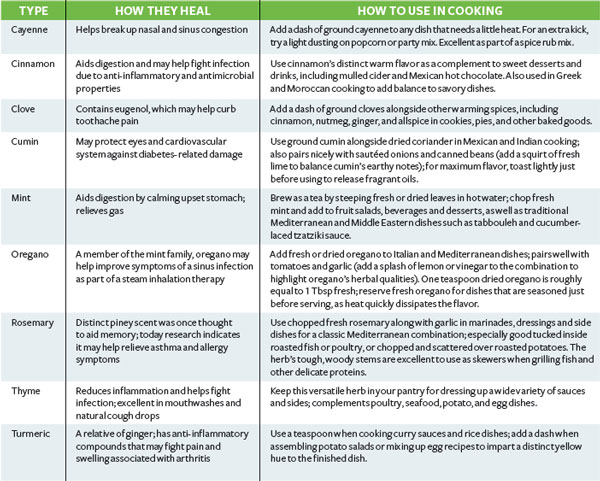
See Sugar and Other Sweeteners
See Melons
See Condiments
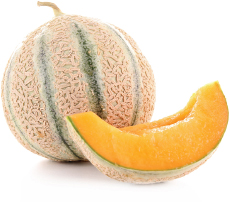
IN MODERATION ONLY
This creamy frozen treat is another one of those fat-sugar combos—like cakes, cookies, and pastries—that’s just so hard to say no to, especially during summer months. Along with loads of calories, ice cream contains big helpings of saturated fat, which is bad for your heart and your waistline. Its redeeming qualities are a healthy dose of calcium and protein. To enjoy the good while limiting the bad, keep portions small, indulge only occasionally, and follow these guidelines.
KEEP IT HEALTHY
Opt for alternatives, such as fruit sorbets or low-fat frozen yogurt. Just be sure to read labels carefully—some of these products may have more sugar and calories.
Look for slow-churned or double-churned. These types of light or reduced-fat ice cream contain up to half the fat and two-thirds the calories of original and have a creamier texture.
Choose cones wisely. A sugar cone contains 60 calories, while a chocolate-dipped waffle cone has more than 200. And avoid high-calorie toppings like candy.
Top it with fruit. The fiber will fill you up so you’ll be satisfied with less. Nuts are another option; just watch the portion size since they’re high in calories.
FOODS
J
IN MODERATION ONLY
High in sugar, jams and jellies are no substitute for the abundant nutrition found naturally in fruits. In fact, most of the vitamin C and other key nutrients are destroyed during the intense cooking process involved in producing them. Low-calorie, reduced-sugar jams aren’t much better because they’re often sweetened with concentrated fruit juice, fructose, and corn syrup and thickened with starches, giving you only empty calories. Soft spread-cheese-based products contain only trace amounts of vitamin A and calcium and are high in sodium, fat, and cholesterol. Chocolate and marshmallow spreads are just spreadable sugar. About the only upside to these products is the quick boost of energy they provide. But that’s really only helpful for people prone to hypoglycemia. So whenever possible, choose the real thing—sliced strawberries with peanut butter for a sandwich, cheese slices on crackers, or melted dark chocolate—instead of the processed stuff. But when you can’t, follow these guidelines.
KEEP IT HEALTHY
Go for all-fruit. Choose preserves made of 100% fruit.
Skip additives. That includes added oils, salt, sugar, and preservatives.
Measure how much you use. And use the least amount possible. A tablespoon (15 mL) of regular jelly has about 60 calories and 11 g of sugar.
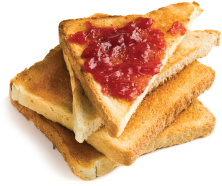
Typical serving size: ½ cup sliced (60 g), 23 calories
HOW IT HARMS
Allergies
WHAT IT HEALS
Cardiovascular disease
Stroke
Weight gain
High blood sugar
Constipation
Skin
Cataracts
NUTRIENTS
Fiber
Potassium
Vitamin C
BUYING
Choose jicama:
| • | between 1 and 2 lb (500 g and 1 kg); larger ones may be less sweet |
| • | with firm, smooth, slightly shiny skin |
| • | that is heavy for its size |
Avoid jicama that is:
| • | blemished or cracked |
| • | moldy |
| • | discolored |
Best time to buy: late autumn through spring
STORING
Where: Refrigerator.
How: Uncut, in a plastic bag; cut, wrapped in plastic.
For how long: Uncut, 2 to 3 weeks; cut, up to 1 week.

COOKING
| • | Peel jicama and remove the fibrous white area just beneath the skin. |
| • | Season jicama sticks with lime juice and chili powder. |
| • | Eat it with a dip, diced in a salad, or added to stir-fries. |
| • | Top jicama slices with tapenade for an appetizer. |
| • | Shred jicama and add it to slaws. It’s a great topping for fish tacos. |
RECIPES TO TRY
| • | Orange Beef with Broccoli and Jicama |
| • | Avocado, Jicama, and Orange Salad |
| • | Jamaican Jerked Chicken Salad |
IN MODERATION ONLY
Even if you choose the healthiest juices, they still contain a lot of calories because of the natural fruit sugar. Canned or bottled vegetable juices tend to have less sugar than fruit juices but more salt, which can increase blood pressure. Fruit juice should not be given to infants under 6 months old because it can cause diarrhea, poor weight gain or delayed development, and tooth decay. If consumed in moderation, drinking juice can be an easy way to get more of the recommended 5 to 10 servings of fruits and vegetables. About 4 oz (125 mL) of juice is equal to 1 serving. Since juice lacks fiber and other compounds found in whole pieces of fruit and vegetables, it’s best to make only 2 or 3 of your fruit servings from juice. And when you do, choose wisely.
KEEP IT HEALTHY
Strive for 100%. Look for juices labeled “100% juice” for the most nutrients.
Go unsweetened. Choose juices that do not have added sugars.
Look for plant sterols. These cholesterol-lowering compounds that have been used in margarine are now showing up in orange juice.
Step away from “fruit drinks” and “fruit punch.” They contain extra sugar (usually corn syrup) and other additives with less actual fruit juice.
FOODS
K
See also Spinach
Typical serving size: ½ cup cooked, chopped (65 g), 18 calories
HOW THEY HARM
Bloating and flatulence
WHAT THEY HEAL
Cardiovascular disease
Cancer
Eye conditions
Bone health
NUTRIENTS
Beta-carotene
Bioflavonoids
Calcium
Carotenoids
Fiber
Folate
Indoles (anticancer compounds)
Iron
Lutein (antioxidant)
Magnesium
Potassium
Vitamin C
BUYING
Choose kale that has:
| • | crisp edges |
| • | deep color |
| • | small to medium size leaves |
Avoid kale that has:
| • | wilted leaves |
| • | yellowed or brown leaves |
STORING
Where: Refrigerator.
How: Rinsed, slightly damp, wrapped in a paper towel, and in a plastic bag.
For how long: Within 3 days.
COOKING
| • | Simmer finely chopped mustard greens in vegetable soup. |
| • | Add some chopped Italian lacinato kale to marinara sauce for pasta. |
| • | Stuff blanched collard green leaves instead of cabbage leaves. |
RECIPES TO TRY
| • | Summer Greens Scramble |
| • | Baked Pasta with Garlic and Greens |
| • | Chicken-Kale Soup with Roasted Pepper Puree |
See Condiments
Typical serving size: 1 large kiwi or ½ cup sliced (90 g), 56 calories
WHAT THEY HEAL
High blood pressure
High cholesterol
Cancer
Macular degeneration
Weight gain
NUTRIENTS
Lutein (antioxidant)
Pectin (soluble fiber)
Phytochemicals
Potassium
Vitamin C
Vitamin E
Zeaxanthin (antioxidant)
BUYING
Choose kiwis that:
| • | are firm, but give to slight pressure |
| • | have rough, fuzzy skin |
Avoid kiwis that are:
| • | blemished |
| • | wrinkled |
STORING
Where: Room temperature, or in the refrigerator.
How: Unpeeled and uncut.
For how long: About 1 week at room temperature; up to 4 weeks in the fridge.
COOKING
| • | Kiwi skin is edible if it is de-fuzzed. |
| • | Toss chunks with strawberries and chopped fresh mint. |
| • | Grill unpeeled halved kiwi to serve with grilled pork chops. |
| • | Serve kiwi slices over lemon yogurt. |
RECIPES TO TRY
| • | Tropical Fruit Salad |
| • | Jamaican Jerked Chicken Salad |
QUICK TIP: Tenderize meat with kiwis
Rub meat with a cut kiwi and wait 30 to 60 minutes before cooking to tenderize.
Typical serving size: 1 cup raw, chopped (135 g), 36 calories
HOW IT HARMS
Bloating and flatulence
WHAT IT HEALS
Cancer
Cardiovascular disease
NUTRIENTS
Bioflavonoids
Fiber
Indoles (anticancer compounds)
Iron
Isothiocyanates (anticancer compounds)
Potassium
Vitamin C
BUYING
Choose kohlrabi with:
| • | a diameter of less than 3 in (7.5 cm) (larger ones can be tough and woody) |
| • | thin rinds |
| • | fresh tops |
Avoid kohlrabi with:
| • | blemishes |
| • | cracks |
STORING
Where: Crisper drawer of refrigerator.
How: Remove leaf stems and place in a sealed plastic bag.
For how long: Several weeks.
COOKING
| • | Simmer chunks of kohlrabi with green split peas to puree for soup. |
| • | Stir-fry chopped kohlrabi with a slice of diced bacon until crisp-tender. |
| • | Serve raw kohlrabi sticks on a veggie platter with dip. |
RECIPES TO TRY
| • | Maple-Glazed Chicken with Root Vegetables |
FOODS
L
Typical serving size: 3 oz (85 g), 160-200 calories, depending on cut
HOW IT HARMS
Weight gain
WHAT IT HEALS
Muscles
Anemia
Immunity
NUTRIENTS
Conjugated linoleic acid (fatty acids that improve cholesterol levels)
Iron
Phosphorous
Potassium
Protein
Vitamin B12
Zinc
BUYING
Look for lamb that is:
| • | firm |
| • | red colored with some white marbling |
Avoid lamb that:
| • | has holes in its packaging |
| • | is past the “use-by” date |
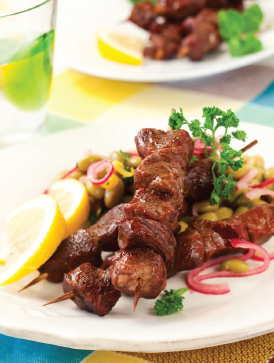
STORING
Where: In the refrigerator at 40°F (4°C) or below, or in the freezer.
How: In its original packaging and covered to prevent cross-contamination (overwrap tightly when freezing).
For how long: 1 to 2 days for ground lamb or stew meat in the fridge (3 to 4 months in the freezer); 3 to 5 days for lamb chops, roasts, and steaks in the fridge (6 to 9 months in the freezer).
COOKING
| • | Sauté thinly sliced lamb with slivered onions and curry powder. |
| • | Stuff a pita bread half with sliced roast lamb, cucumber, plain yogurt, and fresh dill. |
| • | Marinate skewered chunks of lamb, onion, and bell pepper in lemon-garlic salad dressing before grilling. |
RECIPES TO TRY
| • | Skillet Okra and Lamb |
| • | Lamb Burgers with Fruit Relish |
| • | Savory Lamb Stew with Sweet Potatoes |
| • | Greek Lamb Kebabs |
Typical serving size: 1 raw (89 g), 50 calories
HOW THEY HARM
Flatulence
WHAT THEY HEAL
Cancer
High cholesterol
High blood pressure
NUTRIENTS
Beta-carotene
Kaempferol (anticancer compound)
BUYING
Choose leeks that have:
| • | firm, crisp stalks |
| • | as much white and light green regions as possible |
Avoid leeks that have:
| • | yellow or withered tops |
STORING
Where: Refrigerator.
How: Unwashed, in a plastic bag.
For how long: Up to 2 weeks.
COOKING
| • | Serve steamed whole leeks with cheddar cheese sauce. |
| • | Roast chunks of leeks with brussels sprouts tossed in canola oil and sprinkled with sesame seeds. |
| • | Toss sliced raw leeks with beets in reduced-fat ranch dressing. |
| • | Chop green tops of leeks and add to soups and stocks. |
RECIPES TO TRY
| • | Lentil and Rice Paella with Clams |
| • | Pasta with Cabbage, Apples, and Leeks |
| • | Vegetable Stock |
Typical serving size: ½ cup sectioned and peeled (106 g), 31 calories
HOW THEY HARM
Skin irritation
Fungicides and pesticides
Sun sensitivity
Canker sores
Tooth enamel damage
WHAT THEY HEAL
High cholesterol
Cancer
Cardiovascular disease
Kidney stones
Varicose vein pain
Dry mouth
NUTRIENTS
Bioflavonoids (anticancer compound)
Limonene (in the zest; cholesterol-lowering compound)
Rutin (flavonoid)
Vitamin C
BUYING
Look for lemons and limes that are:
| • | not waxed |
| • | heavy for their size |
| • | bright skinned |
Avoid lemons and limes that have:
| • | bruises or wrinkles |
| • | large blemishes or discoloration |
| • | soft spots |
STORING
Where: At room temperature or in the crisper drawer of refrigerator.
How: In a plastic bag in the refrigerator.
For how long: Several days at room temperature; about 2 weeks in the refrigerator.
COOKING
| • | Macerate sliced strawberries in lemon juice and a sprinkling of sugar. |
| • | Stuff a halved lemon and bouquet garni into the chicken cavity before roasting. |
| • | Toss grated lime peel and juice with hot cooked quinoa. |
| • | Freeze lemon or lime juice mixed with the grated peel in small resealable freezer bags for convenience. |
| • | Use lime juice as a salt substitute for meat and fish dishes. |
RECIPES TO TRY
| • | Scallops Florentine |
| • | Trout with Lemon-Mushroom Stuffing |
| • | Shellfish Salad with Herbed Lemon Dressing |
| • | Grilled Chicken Sandwiches with Basil Mayonnaise |
| • | Angel Food Cake with Strawberries |
See also Beans and Other Legumes
Typical serving size: ½ cup cooked (99 g), 115 calories
HOW THEY HARM
Bloating and flatulence
WHAT THEY HEAL
High cholesterol
Blood sugar spikes
Weight gain
Constipation
Anemia
Cardiovascular disease
Reproductive health
Cancer
NUTRIENTS
B vitamins
Fiber
Folate
Iron
Magnesium
Niacin
Potassium
Protein
BUYING
Choose lentils that are:
| • | uniform size |
| • | brightly colored |
Avoid lentils that are:
| • | not in clear packaging |
| • | cracked, shriveled, or have holes |
The common khaki-colored lentils are widely available in supermarkets; the more delicate green and red lentils may be harder to find.

STORING
Where: A cool, dry place.
How: In an airtight container.
For how long: Up to 6 months. Cooked lentils may be stored in a sealed container in the refrigerator for up to 1 week.
COOKING
| • | Sort through lentils before cooking and discard any that are shriveled. |
| • | Don’t mix new lentils with older ones, because older lentils will take longer to cook. |
| • | Red lentils cook faster than the khaki ones. |
| • | Coarsely grind cooked seasoned lentils in a food processor, then shape into patties for frying or grilling. |
| • | Use lentils in place of beans in minestrone. |
| • | Toss cooked lentils with cooked rotini pasta and shredded provolone cheese. |
RECIPES TO TRY
| • | Lentil and Rice Paella with Clams |
| • | Artichokes with Lentils and Lima Beans |
| • | Lentil Soup with Canadian Bacon |
See also Spinach
Typical serving size: 1 cup (20 to 55 g depending on variety), 4 to 10 calories
HOW THEY HARM
Food poisoning
WHAT THEY HEAL
Cancer
Cardiovascular disease
Weight gain
NUTRIENTS
Antioxidants
Beta-carotene
Calcium
Folate
Iron
Potassium
Vitamin C
Amounts vary from one variety to another, with dark green or other deeply colored leaves being more nutritious than paler varieties. Arugula, watercress, escarole, and mache are some of the most nutritious varieties.
BUYING
Look for lettuce with:
| • | fresh, crisp leaves |
| • | good, bright color |
Avoid lettuce with:
| • | decay like wilting or sliminess |
| • | blemishes |
| • | tip burn, a tan or brown area around the margins of the leaves |
| • | very hard or irregular shaped heads |
| • | insect damage |
STORING
Where: Crisper drawer of the refrigerator.
How: Discard brown and wilted leaves, separate leaves and rinse, spin them dry, and layer between sheets of paper towel.
For how long: Up to 1 week; if using within 3 days, you can store greens in a plastic bag in the refrigerator.
COOKING
| • | Pair romaine lettuce with apples, pecans, blue cheese and cider vinaigrette. |
| • | Try arugula with beets, walnuts, feta cheese, and red wine vinaigrette. |
| • | Stir-fry sliced romaine lettuce with some Chinese black beans and grated ginger as a side dish. |
| • | Make a pureed soup by blending simmered lettuce, garlic, thyme, and chicken broth; garnish with grated parmesan. |
| • | Braise sliced escarole with raisins, garlic, balsamic vinegar, and a pinch of ground red pepper. |

QUICK TIP: Dress your salad with a little oil
Oil enhances the absorption of beta-carotene, which is plentiful in arugula and romaine varieties of lettuce. Beta-carotene plays an important role in preventing cancer and vision loss.
RECIPES TO TRY
| • | Watermelon and Feta Salad |
| • | Asian Chicken Salad |
| • | Buckwheat Noodles with Tofu and Green Vegetables |
| • | Endive, Apple, and Watercress Salad |
| • | Salmon and Fennel Lettuce Wraps |
See Lemons and Limes
See Organ Meats
See Shellfish
FOODS
M
Typical serving size: ½ cup sliced (83 g), 54 calories
WHAT THEY HEAL
Cancer
High blood pressure
High cholesterol
Weight gain
NUTRIENTS
Beta-carotene
Pectin (soluble fiber)
Potassium
Vitamin C
BUYING
Look for mangoes that:
| • | yield slightly when gently pressed |
| • | emit a fruity aroma |
| • | have a green or yellow-green color with a red blush |
Avoid mangoes that:
| • | have large dark spots |
| • | are completely green |
| • | have shriveled skin |
Best time to buy: summer
STORING
Where: At room temperature and out of the sun until ripened; in refrigerator, once ripe.
How: In a plastic bag if cut.
For how long: 1 to 2 weeks uncut; no more than 3 days once cut.
COOKING
| • | Use mangoes in any recipe that calls for peaches. |
| • | Sprinkle mango chunks with toasted coconut. |
| • | Add mango chunks to a pork stir-fry. |
RECIPES TO TRY
| • | Broiled Salmon with Avocado-Mango Salsa |
| • | Fruit Salad with Spiced Coconut |
| • | Indian-Style Turkey Burger |
| • | Fish Tacos |
| • | Yogurt Parfait |
Typical serving size: ½ cup diced (78 to 85 g), 23 to 31 calories, depending on type
HOW THEY HARM
Bacterial infection
WHAT THEY HEAL
Cancer
Cardiovascular disease
High blood cholesterol
Weight gain
NUTRIENTS
Beta-carotene
Bioflavonoids and carotenoids (anticancer compounds)
Fiber
Lycopene (antioxidant in watermelons)
Potassium
Vitamin C
BUYING
Look for melons that:
| • | are whole to preserve nutritional content |
| • | have a smooth, slightly sunken scar near where the stem was |
| • | have a deep, intense fragrance |
| • | rattle when shaken or produce a slightly hollow sound when thumped |
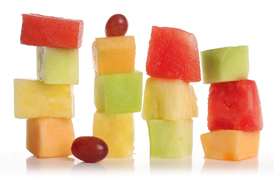
QUICK TIP: Keep ‘em juicy
When storing slices of cantaloupe or honeydew, keep the seeds intact if possible. This will prevent the fruit from drying out.
Avoid melons that:
| • | are lopsided or have a flat side |
| • | have cracks, soft spots, or dark bruises |
| • | have stems on the scar |
Best time to buy: summer to early autumn
STORING
Where: Crisper drawer of refrigerator.
How: Whole and unwashed; in a sealed container if cut.
For how long: 5 to 7 days; the riper they are, the shorter they will keep. Toss cut melons that have been left at room temperature for more than 4 hours.
COOKING
| • | Before cutting, scrub the skin with a clean vegetable brush under running water and blot it dry. |
| • | Add finely chopped watermelon to barbecue sauce. |
| • | Grill sliced honeydew melon with Cajun seasoned catfish fillets. |
| • | Stir cantaloupe cubes into chicken salad. |
RECIPES TO TRY
| • | Crab Cakes with Melon Relish |
| • | Chicken-Melon Salad |
| • | Cantaloupe and Orange Soup |
| • | Fruit Parfait with Ginger Tea Cream |
See also Butter and Margarine; Cheese; Ice Cream; Yogurt
Typical serving size: 1 cup (236 mL), calories vary (see chart Which Milk Should You Drink?)
HOW THEY HARM
High cholesterol (whole milk and milk products)
Lactose intolerance
Allergies
Acne
WHAT THEY HEAL
Bone loss
Insulin resistance
High blood pressure
NUTRIENTS
Calcium
Magnesium
Potassium
Protein
Riboflavin
Vitamin B12
Vitamin D
BUYING
Choose milk:
| • | dated several days in the future (the date on the carton indicates the last day on which the milk can be sold) |
| • | in a cardboard or opaque container |
Avoid milk:
| • | on or past its “use-by” date |
| • | in a clear or translucent container |
STORING
Where: Toward the back of the refrigerator.
How: A temperature just above freezing is ideal, but milk should not be frozen.
For how long: 1 to 5 days beyond “use-by” date.
In recent years, some new milk options have popped up in grocery stores, and they’re not all created equally. Here’s what you need to know to find the best milk for you.

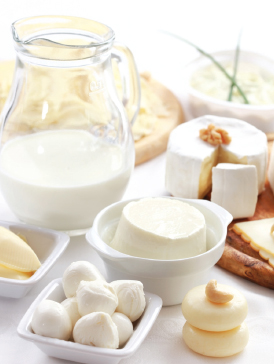
COOKING
| • | Freeze cubes of milk mixed with an equal amount of orange juice; process cubes in a food processor to make sherbet. |
| • | Cook rice in milk instead of water for a creamy side dish. |
| • | Simmer sliced red potatoes and onions in milk for a quick soup; season with dill and black pepper. |
RECIPES TO TRY
| • | Chai |
| • | Macaroni and Cheese with Spinach |
| • | Potato Salad with Sun-Dried Tomatoes, Scallions, and Basil |
QUICK TIP: Try dry milk
To boost calcium, add nonfat dry milk (from a sprinkling up to ¼ cup) when baking or to soups, casseroles, stews, egg dishes, meatloaf, and mashed potatoes. A ¼ cup (125 g) of dry milk has 210 mg of calcium.
Typical serving size: ½ cup raw, sliced (35 g), 8 calories; ½ cup cooked (78 g), 22 calories
HOW THEY HARM
May be poisonous
WHAT THEY HEAL
Cardiovascular disease
High blood pressure
High cholesterol
Prostate and breast cancer
Immunity
Weight gain
NUTRIENTS
Chitin (cholesterol-lowering fiber)
Lentinan (phytochemical that may help boost immunity)
Niacin
Potassium
Selenium
BUYING
Choose mushrooms that are:
| • | firm buttons |
| • | large; the largest of any variety have the most flavor |
Avoid mushrooms with:
| • | bruises |
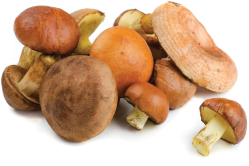
STORING
Where: Crisper drawer of refrigerator.
How: In a paper bag.
For how long: 5 days.
COOKING
| • | Rinse mushrooms only before using them. Do not peel them or remove the stalks. |
| • | Squeeze a little lemon juice on mushrooms to retain their color. |
| • | Mix sautéed chopped mushrooms into turkey meat loaf. |
| • | Grill portobello mushroom caps mounded with wild rice stuffing. |
| • | Sprinkle truffle oil over sautéed mushrooms as a bruschetta topping. |
RECIPES TO TRY
| • | Mushroom and Bell Pepper Frittata |
| • | Trout with Lemon-Mushroom Stuffing |
| • | Bok Choy, Tofu, and Mushroom Stir-Fry |
| • | Baked Rice with Wild Mushrooms and Cheese |
| • | Vegetable-Stuffed Mushrooms |
See Kale and Other Cooking Greens
FOODS
N
See also Flax; Peanuts and Peanut Butter
Typical serving size: 1 oz (28g), calories vary (see chart Which Nut and Seed is Best?)
HOW THEY HARM
High in fat and calories
Allergies
Dehydration (chia seeds)
WHAT THEY HEAL
Diabetes
Cardiovascular disease
High cholesterol
Cancer
Low energy
Constipation
Anemia
Weight gain
NUTRIENTS
Calcium
Fiber
Flavonoids
Folate
Iron
Magnesium
Manganese
Monounsaturated fats
Omega-3 fatty acids
Potassium
Protein
Selenium
Vitamin E
Zinc
BUYING
Choose nuts or seeds that are:
| • | plump |
| • | uniform in color and size |
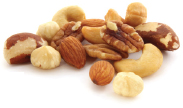
While these little gems are high in fat and calories, most of it is healthy poly-unsaturated and monounsaturated fat. To keep your waistline from expanding as you enjoy all the good nutrition in nuts and seeds, keep an eye on your portions. Here are guidelines for serving sizes and how many calories they pack.

Avoid nuts or seeds that are:
| • | moldy |
| • | close to or past their “use-by” date |
STORING
Where: Cool, dry place when unopened, in the refrigerator once opened.
How: In an airtight container or sealed plastic bag.
For how long: Up to 6 months.
COOKING
| • | Sprinkle lemon-pepper seasoning over hot roasted sunflower seeds. |
| • | Scatter chopped walnuts over a chicken stir-fry. |
| • | Scatter pistachios over a salad of watercress, sliced orange, and red onion. |
| • | Sprinkle sesame seeds into tuna salad. |
| • | Puree raw almonds, roasted red peppers, and garlic as a sandwich spread. |
RECIPES TO TRY
| • | Pasta with Walnut Cream Sauce |
| • | Spiced Almonds |
| • | Blueberry and Cranberry Granola |
| • | Cauliflower Salad with Cashews |
| • | Balsamic Beets with Toasted Pecans |
FOODS
O
See also Grains
Typical serving size: ½ cup cooked with water (117 g), 83 calories
HOW THEY HARM
Blood sugar spikes (instant oatmeal)
WHAT THEY HEAL
Cardiovascular disease
High cholesterol
High blood pressure
Diabetes
Constipation
Weight gain
NUTRIENTS
Beta-glucan (soluble fiber that can help lower cholesterol)
Calcium
Folate
Iron
Manganese
Polyphenols and saponins (antioxidants)
Protein
Thiamine
Vitamin E
BUYING
Choose:
| • | steel-cut or whole oat products |
Avoid:
| • | flavored or instant oatmeal |
STORING
Where: A cool, dry place or freezer.
How: In an airtight container; in a plastic bag with the air squeezed out if freezing.
For how long: About a year.
COOKING
| • | Stir ¼ cup steel-cut oats into a beef stew to thicken. |
| • | Sprinkle rolled oats atop quick bread loaves before baking. |
| • | Serve cooked oats topped with a poached egg. |
| • | Use rolled oats instead of breadcrumbs in meat loaf, or to coat chicken or fish patties before cooking. |
RECIPES TO TRY
| • | Hot Cereal with Apples and Dates |
| • | Multigrain Pancakes or Waffles |
| • | Spinach Stuffed Meat loaf |
| • | Chewy Oatmeal Raisin Cookies |
| • | Cherry Crisp |
See also Olives and Olive Oil
Typical serving size: 1 Tbsp (15 mL), 120 calories
HOW THEY HARM
High in saturated fat (coconut, palm kernel, and palm oil)
Bacterial infection
WHAT THEY HEAL
High cholesterol
Hormone production
Nutrient absorption
NUTRIENTS
Monosaturated and omega-3 fats
BUYING
Choose:
| • | single-source oils, such as pure canola or pure olive |
Avoid:
| • | blended oils |
STORING
Where: A cool, dark place.
How: In original container.
For how long: About 6 months.
COOKING
| • | Choose canola oil for sautéeing or stir-frying. |
| • | Use olive oil in a carrot muffin recipe. |
| • | Drizzle roasted sesame oil over zucchini wedges after they’re grilled. |
RECIPES TO TRY
| • | Romaine Lettuce with Chunky Tomato Vinaigrette |
| • | Buckwheat Noodles with Tofu and Green Vegetables |
| • | Walnut Shortbread |
Typical serving size: ½ cup cooked (80 g), 18 calories
WHAT IT HEALS
High cholesterol
Constipation
Weight gain
NUTRIENTS
Beta-carotene
Fiber
Folate
Magnesium
Pectin (soluble fiber)
Potassium
Thiamine
Vitamin C
BUYING
Choose okra with:
| • | firm pods |
| • | bright green color |
| • | shallow ridges in pods |
Avoid okra with:
| • | yellow or black discoloration |
| • | shriveling |
| • | any bruising, pitting, or decay |

STORING
Where: Crisper drawer of refrigerator.
How: Unwashed and loosely wrapped in a perforated plastic bag.
For how long: 3 days.
COOKING
| • | Sauté baby okra in canola oil and garlic until crisp-tender, toss with teriyaki sauce. |
| • | Bake whole baby okra flavored with olive oil, fine bread crumbs, garlic, and parmesan cheese. |
| • | Use sliced okra in a chicken potpie filling. |
RECIPES TO TRY
| • | Savory Lamb Stew with Sweet Potatoes |
| • | Skillet Okra and Lamb |
QUICK TIP: Use as a thickener
Okra is high in starch, pectin, and soluble fiber, which help thicken soups and stews when it is cooked. As okra cooks, its fats are released and naturally thicken the soups and stews.
See also Oils
Typical serving size: 4 small olives (13 g), 16 calories; 1 Tbsp oil (15 mL), 120 calories
HOW THEY HARM
Blood pressure (olives)
WHAT THEY HEAL
High blood cholesterol
Cancer
Inflammation
Immunity
Weight gain
NUTRIENTS
Lignans (compounds that may protect against cancer)
Monounsaturated fats
Phytochemicals
Vitamin E
BUYING
Choose:
| • | oils that are minimally processed, such as extra-virgin or cold-pressed |
| • | low-sodium varieties of canned olives |
Avoid:
| • | olives that are soft or mushy |
STORING
Where: Refrigerator for olives; dark, cool place for oil.
How: In an airtight container.
For how long: Up to 2 months for olives; several years for oil (if the oil turns cloudy, toss it).
COOKING
| • | Stir slivered ripe olives into risotto. |
| • | Toss hot spaghetti with extra-virgin olive oil and garlic. |
| • | Add minced green olives to egg salad. |
RECIPES TO TRY
| • | Green Beans with Tomatoes and Olives |
| • | Penne with Fresh Tomato Sauce and Grilled Eggplant |
| • | Grilled Salmon with Sautéed Greens |
| • | Linguine with Clams |
| • | Tuna and Cannellini Salad with Lemon |
Typical serving size: ½ cup raw (80 g), 32 calories
HOW THEY HARM
Bloating and flatulence
WHAT THEY HEAL
Lung cancer and other cancers
Heart attacks
High cholesterol
High blood sugar
Bacterial infections
NUTRIENTS
Beta-carotene
Chromium
Flavonoids
Potassium
Vitamin C
BUYING
Choose onions that:
| • | are firm |
| • | have crackly, dry skin |
| • | have a mild odor |
| • | have fresh, crisp, green tops that extend 2 to 3 in (5 to 7.5 cm) up from the root (spring onions/scallions) |
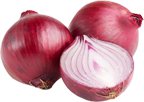
QUICK TIP: Go raw
Cooking onions at a high heat significantly reduces the benefits of diallyl sulfide, their cancer-protective phytochemical. For the biggest health boost, enjoy fresh raw onions. Mincing (or even chewing) the onion helps to release its phytochemical power.
Avoid onions that:
| • | feel soft |
| • | have black spots |
| • | have green sprouts showing at the top |
| • | have a strong, oniony smell |
| • | have yellowing, wilted, discolored, or decayed tops (spring onions/scallions) |
STORING
Where: A cool, dry place away from direct light and away from potatoes. Store scallions and cut onions in the refrigerator.
How: With skin on for whole onions; tightly wrapped in plastic if cut; in a plastic bag for scallions.
For how long: 3 to 4 weeks uncut; 2 to 3 days cut; 3 days for scallions (use them before they begin to soften).
COOKING
| • | Broil pita bread topped with sautéed onions and grated swiss cheese until bubbly. |
| • | Stir sliced scallions into scrambled eggs. |
| • | Marinate slivers of sweet onion in cider vinegar in the refrigerator for several hours to make quick pickled onions. |
RECIPES TO TRY
| • | Pineapple-Chipotle Chicken |
| • | Herbed Turkey Meatballs and Fusilli |
| • | Spinach Salad with Chickpeas |
| • | Tuscan Bean Soup |
| • | Sloppy Joes |
Typical serving size: 1 medium orange (131 g), 63 calories; 1 medium tangerine (109 g), 50 calories; ½ cup juice (4 fl oz, 120 mL), 52 calories
HOW THEY HARM
Allergies
Tooth enamel erosion
Drug interaction
Canker sores
WHAT THEY HEAL
Cancer, including thyroid cancer
High blood pressure
High cholesterol
Inflammation
Weight gain
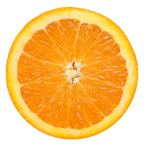
QUICK TIP: Don’t be a perfect peeler
Eat the orange with the pith, the spongy white layer between the zest and the pulp. Although bitter, the pith stores a good amount of the fruit’s fiber and antioxidant plant chemicals.
NUTRIENTS
Beta-carotene
Bioflavonoids
Fiber
Folate
Nobiletin (flavonoid that may have anti-inflammatory actions)
Potassium
Thiamine
Vitamin C
BUYING
Choose oranges that:
| • | are firm |
| • | are heavy for their size |
| • | have bright orange skin |
Avoid oranges that:
| • | have bruised, wrinkled skin |
| • | are discolored |
| • | are canned |
Best time to buy: winter and spring
STORING
Where: At room temperature, or crisper drawer of refrigerator (preferred spot for tangerines).
How: Unpeeled.
For how long: Up to 2 weeks.
COOKING
| • | Mix orange chunks with cottage cheese and mint. |
| • | Quickly sauté orange slices as a topping for vanilla ice cream. |
| • | Simmer tangerine sections, sliced pears, brown sugar, and a pinch of cloves in a saucepan to make a compote to serve with yogurt or on toast. |
| • | Grill tangerine sections with sea scallops threaded on skewers. |
RECIPES TO TRY
| • | Orange Beef with Broccoli and Jicama |
| • | Cantaloupe and Orange Soup |
| • | Orange and Pomegranate Compote |
| • | Asian Chicken Salad |
| • | Orange Beets |
Typical serving size: 3 to 4 oz (85 to 115 g), 165 to 216 calories
HOW THEY HARM
Toxins
Gout
High cholesterol
Vitamin A toxicity
Creutzfeldt-Jakob disease risk
WHAT THEY HEAL
Anemia
Vitamin B12 deficiency
Protein deficiency
NUTRIENTS
Folate
Iron
Niacin
Potassium
Protein
Vitamin B12
Zinc
BUYING
Choose organ meat that:
| • | is from a local butcher |
| • | has the Safe Food Handling label on the package when buying at a supermarket |
| • | is tightly wrapped and cold to the touch |
| • | is shiny |
| • | has a pleasant smell |
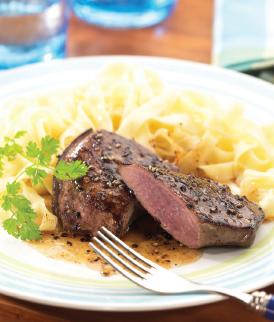
Avoid organ meat that is:
| • | soaking in a large amount of liquid |
STORING
Where: In the coldest part of the refrigerator or the meat drawer or bin.
How: Loosely wrapped.
For how long: 1 to 2 days (3 to 4 months if frozen).
COOKING
| • | Sauté chicken livers and minced onion, mash, and use as a sandwich spread. |
| • | Add some finely chopped beef tripe to chili. |
| • | Sauté veal sweetbread with chopped bacon. |
RECIPES TO TRY
| • | Calf’s Liver with Rigatoni |
See Shellfish